EDITOR’S NOTE: This Croatian food guide was written by Traveleater BJ Young and verified by Martina Rožman, a professional writer and food connoisseur from Zagreb, Croatia.
The source of Croatian food’s intricacy and multi-layered character might be best captured by one of the country’s winemakers, Ivica Matošević, who told The Huffington Post, “My grandfather lived in Austria, my father was born in Italy, I was raised in Yugoslavia, and my daughter was born in Croatia, yet nobody ever moved.”
Like the country itself, Croatian cuisine has absorbed multiple influences, from the highlights of the Mediterranean diet to the hearty fare of Eastern Europe. Add to that the bounties of the Adriatic Sea, and you have one of the most remarkable arrays of gastronomic riches.
While no list can be comprehensive enough to do justice to the incredible experience in store for epicures in Croatia, here are forty of the tastiest examples of traditional Croatian food to whet your appetite before your next visit to the Balkans.
CROATIAN FOOD QUICK LINKS
If you’re planning a trip to Croatia and want to really dive into the cuisine, then you may be interested in joining a food tour or taking a cooking class.
TOURS & OTHER SERVICES
- Food Tours: Food and Wine/Drinking Tours in Croatia
- Cooking Classes: Cooking Classes in Croatia
- eSIM: Croatia eSIM
Save This on Pinterest!
No time to read this article on traditional Croatian foods? Click on the save button and pin it for later!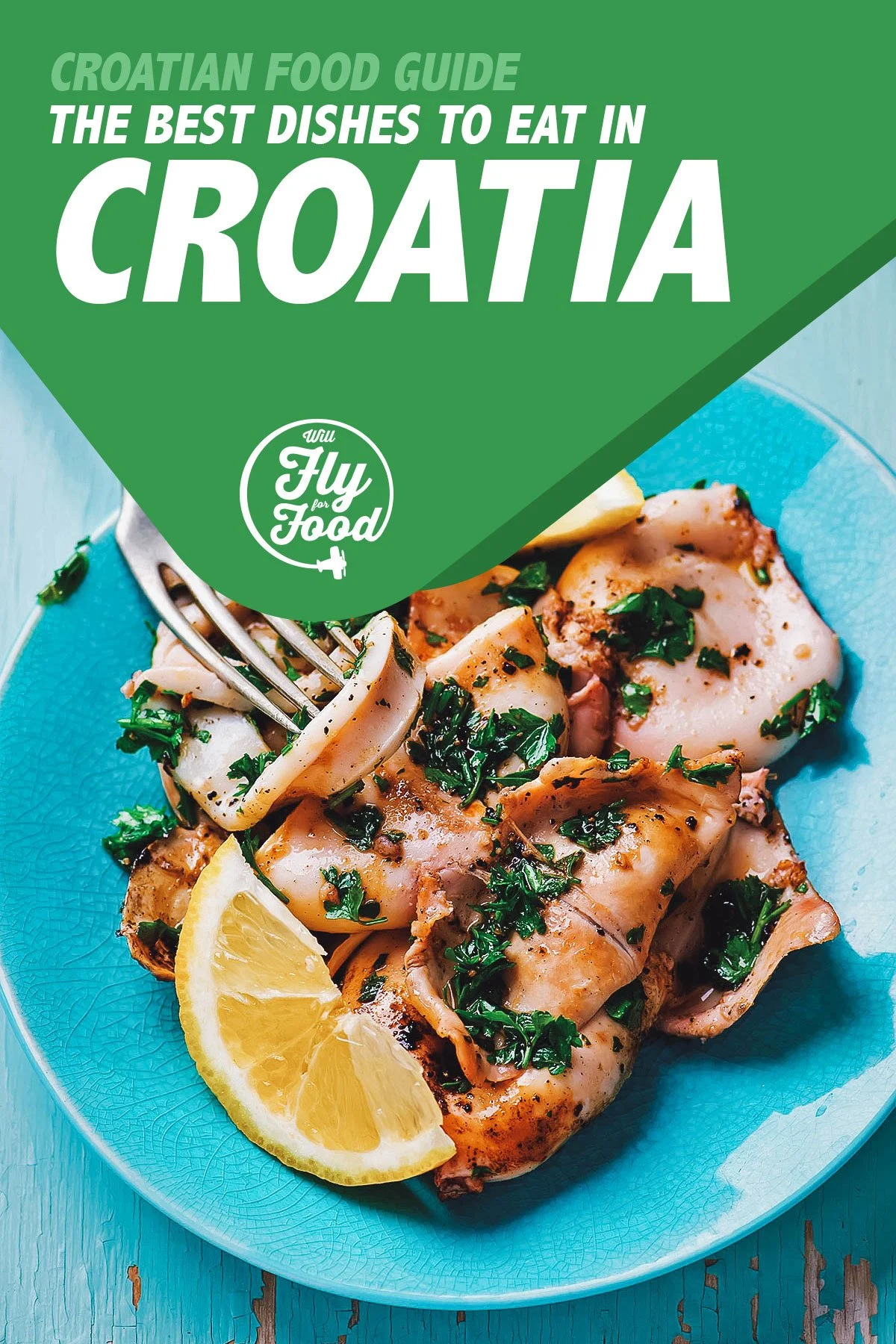
Photo by zoryanchik
WHAT IS TRADITIONAL CROATIAN FOOD?
Traditional Croatian food dates back to ancient times and can vary greatly from region to region.
In the mainland, its characterized by Slavic influences and the more recent interactions with Hungarian and Turkish cuisine. Lard is often used for cooking while some of the most common spices include garlic, black pepper, and paprika.
Along the coast, Croatian food bears a closer resemblance to Greek and Mediterranean cuisine. Seafood is abundant and olive oil is commonly used. Coastal Croatian food seems to be more varied in its seasonings with herbs and spices like rosemary, bay leaf, oregano, sage, cinnamon, clove, and citrus zest making their way into many Croatian recipes.
Croatian food is so heterogenous that it can be divided into several distinct regional cuisines – Dalmatia, Lika, Gorski Kotar, Istria, Zagorje, Međimurje, Podravina, Primorje, and Slavonija. Each region has its own distinct characteristics and cooking traditions though most dishes can usually be found throughout the country.
THE BEST OF TRADITIONAL CROATIAN CUISINE
This article on Croatian food has been organized by category to make it easier to digest. Click on a link to jump to any section of the guide.
STARTERS / SIDE DISHES
1. Paški Sir (Pag Cheese)
Pag is an island off the Croatian coast. It’s the fifth-largest Croatian island and home to a sheep population that outnumbers humans by over four to one. With that many sheep on the island, it’s no surprise that Pag produces some of the world’s best and most sought after sheep milk cheese.
Known in Croatian as Paški sir, what makes Pag cheese special is the size and diet of the local sheep. Pag sheep are among the smallest in the Mediterranean and thus produce a small milk yield. However, the milk they do produce is the result of a diet heavy in aromatic herbs crusted with salt swept up by bura from the Adriatic Sea. This leads them to produce a milk that’s uniquely flavored and naturally salty and needs no additional salt to turn into cheese.
Paški sir can be aged for anywhere between five months to over a year, though it’s so highly regarded that it’s often sold after just a few months of maturation. A firm type of cheese, young Pag cheese resembles young Manchego in taste and texture while aged versions are reminiscent of Pecorino Romano. The former is often used as a topping for pasta and risotto while the latter is typically eaten on its own with Croatian olive oil.
Pag cheese is of such high quality that even the curd, known locally as puina, is considered a first-class specialty. It’s commonly served with polenta or pasta and enjoyed as a dessert with Pag honey.
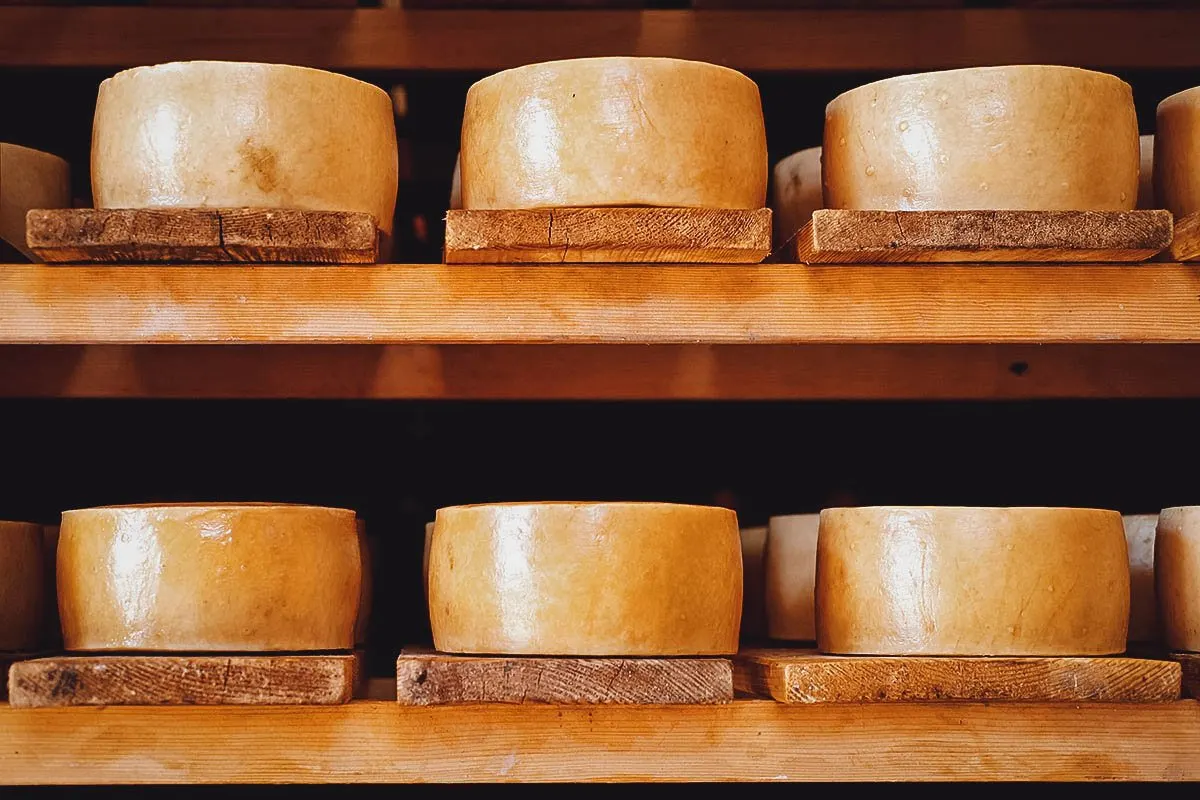
Photo by Mliss
2. Njoki
Njoki is the Croatian version of gnocchi, a type of dumpling made with potato dough. It’s especially popular in the coastal regions of Croatia where it’s served as a first course or side dish with pašticada (braised beef).
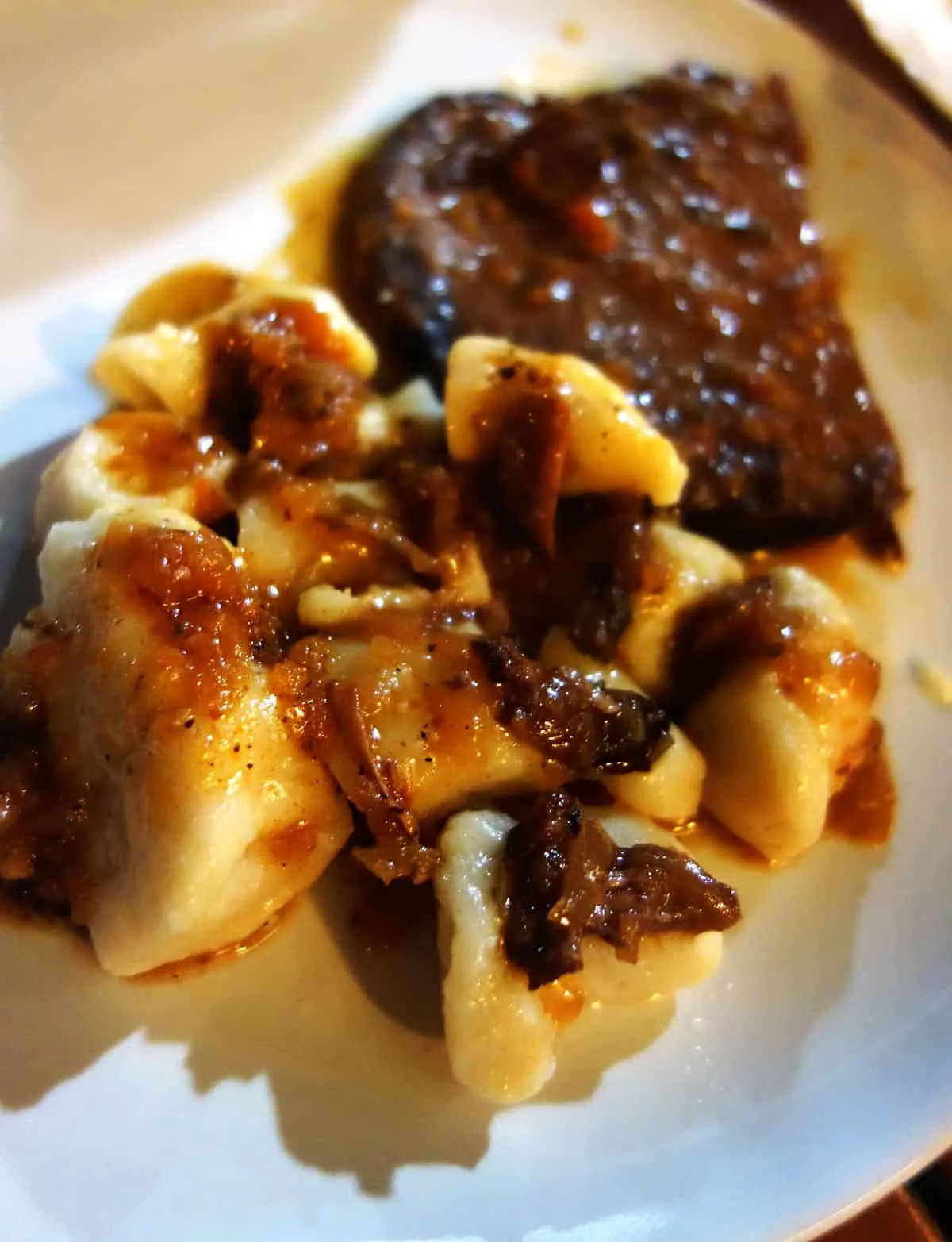
3. Fuži
The Croatian region of Istria is known for its pasta. Pljukanci, ravioli, lazanje, and pasutice are among the most common though the best known is fuži.
Fuži refers to a type of traditional Istrian pasta shaped like a tube. It’s made with thin, diamond-shaped sheets of pasta dough that are folded and pinched together to resemble small flutes or spindles. The name fuži is derived from fusus, which is Latin for “spindle”.
Fuži can be served with many Croatian dishes. It’s often paired with a mild red veal sauce or chicken goulash though it can be served with any type of sauce or Croatian stew. Pictured below is a plate of fuži topped with olive oil and shaved white truffles. Both are delicacies of the Istrian region.
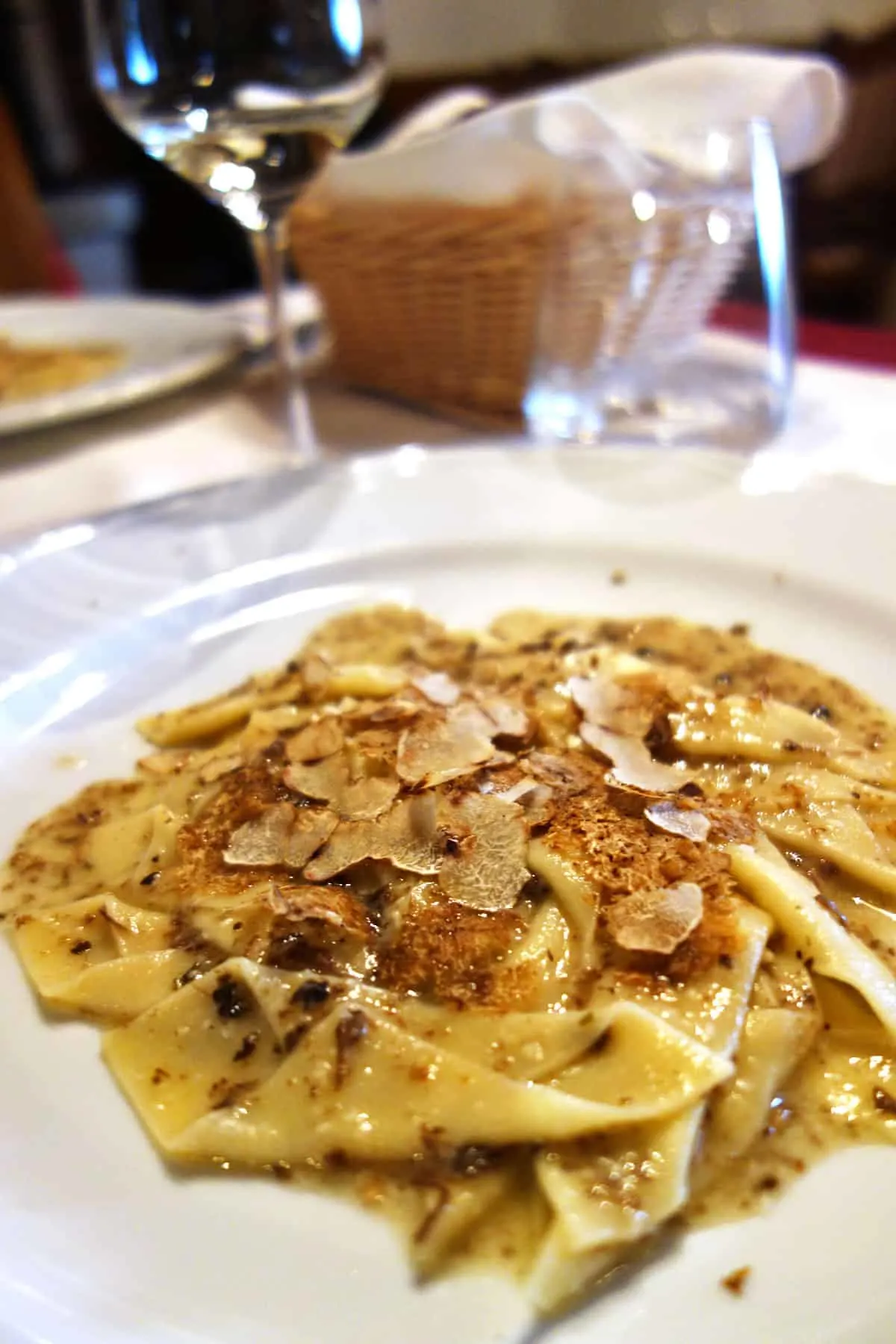
4. Abšmalcane Mahune
Abšmalcane mahune refers to a traditional Croatian dish made with boiled green beans braised with butter and breadcrumbs. It can be made with or without bacon and is often served as a side dish with meat or fish dishes.
Abšmalcane is derived from the German word abschmalzen, meaning “fried with butter”, while mahune refers to the green beans.
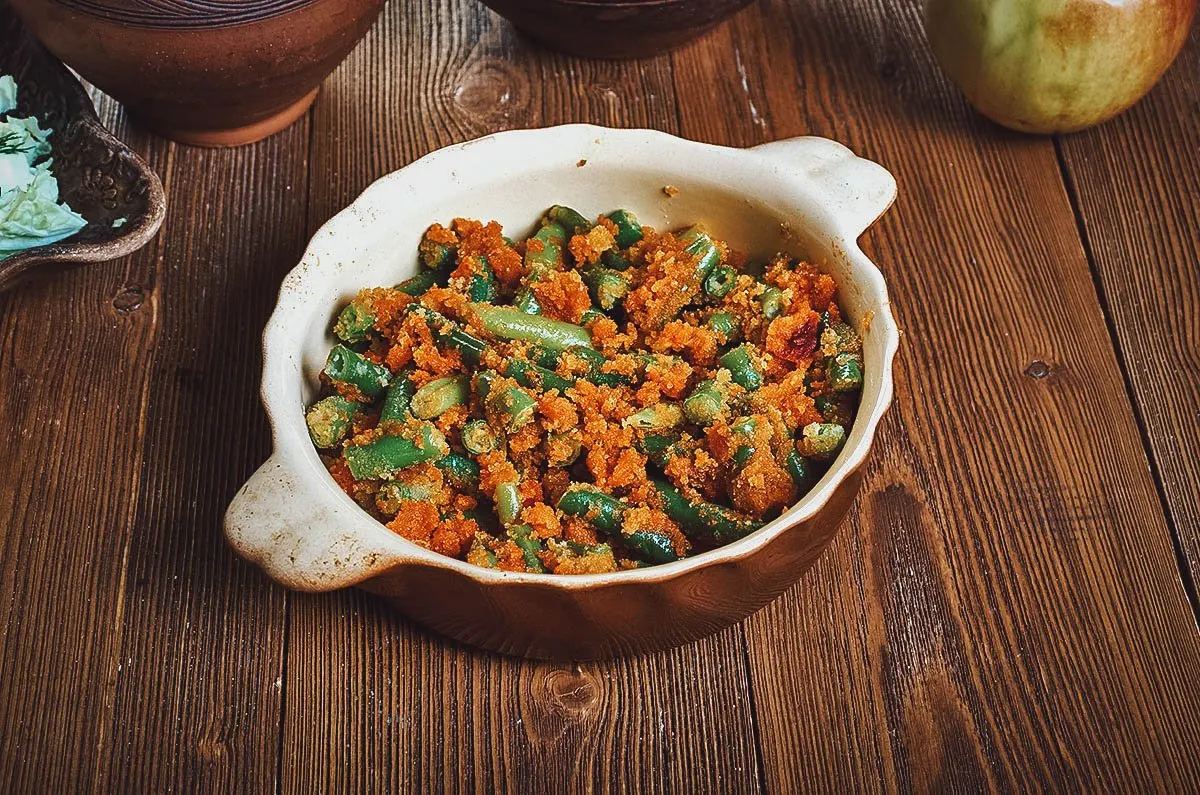
Photo by fanfon
5. Žganci
Žganci refers to a polenta-like dish made with cooked corn grits or corn flour. It’s popular in Croatian and Slovenian cuisine and was historically regarded as a type of “poor man’s food” consumed by peasants as a substitute for bread.
Žganci is a simple dish made with corn flour mixed with water, salt, and some butter. It’s typically eaten for breakfast or as a side dish with milk, yogurt, honey, lard, or bacon.
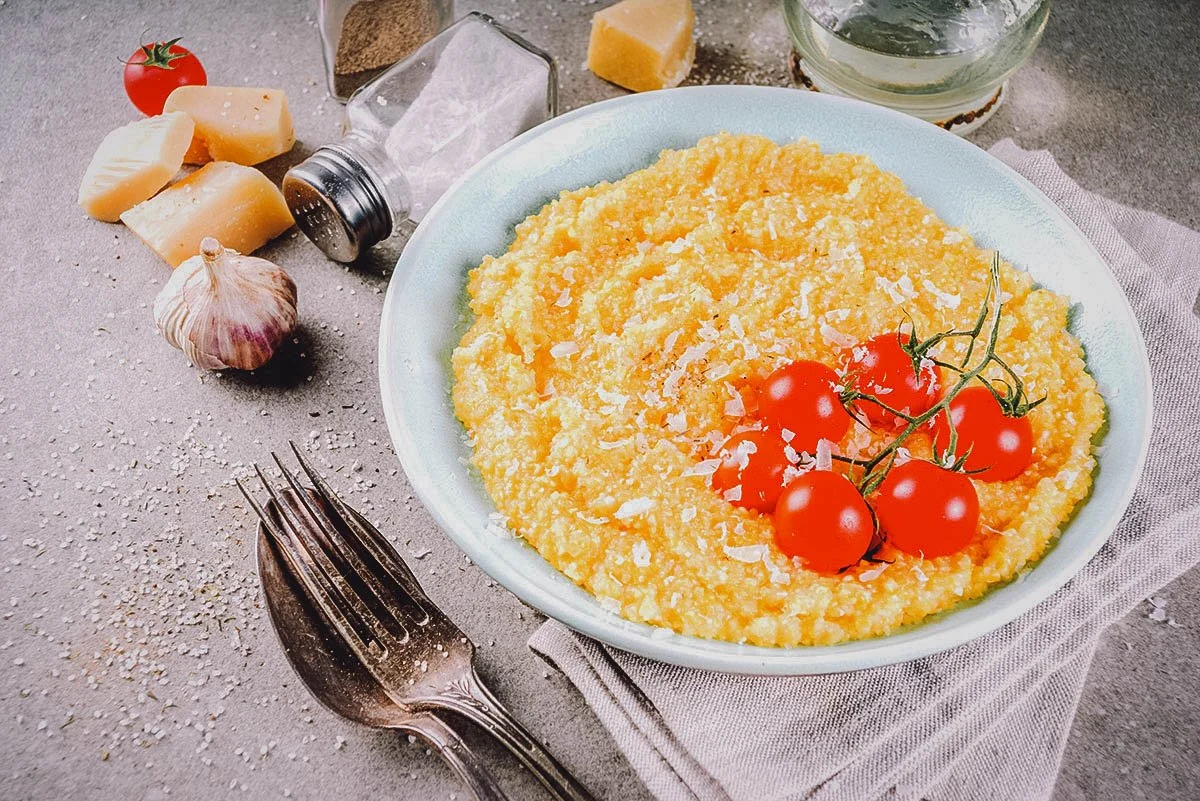
Photo by unixx.0.gmail.com
6. Soparnik
If you’re like most people and love pizza, then you’ll surely enjoy soparnik, a traditional pie-like Croatian dish hailing from the Pojica area in southern Dalmatia. Also known as zeljenik, uljenak, or prisnac, people in the region believe that soparnik was brought to Italy by the Romans and served as the inspiration for pizza.
Soparnik is made with a filling of Swiss chard, spring onions, parsley, salt, and olive oil sandwiched between two sheets of thinly rolled dough. The upper layer is pricked several times with a fork to release steam before the pie is baked on an open hearth called a komin.
What’s interesting about soparnik is that a layer of hot coals from dried grape vines is placed directly on top of the pie as it bakes. After about twenty minutes, the coals are brushed off and the soparnik is topped with olive oil and chopped garlic before being sliced into diamond shapes and then served.
Soparnik can be enjoyed at any time of the year though it was typically made during the colder months when older, sweeter Swiss chard was available. It’s traditionally considered to be a fasting dish that was often served on Good Friday, Christmas Eve, and All Saints’ Day.
In 2016, the European Commission listed soparnik as a non-material, national heritage dish of Croatia and gave it geographical protection status (GPI). What that means is that only versions made with ingredients from the Poljica area and following a specific recipe can be called soparnik.
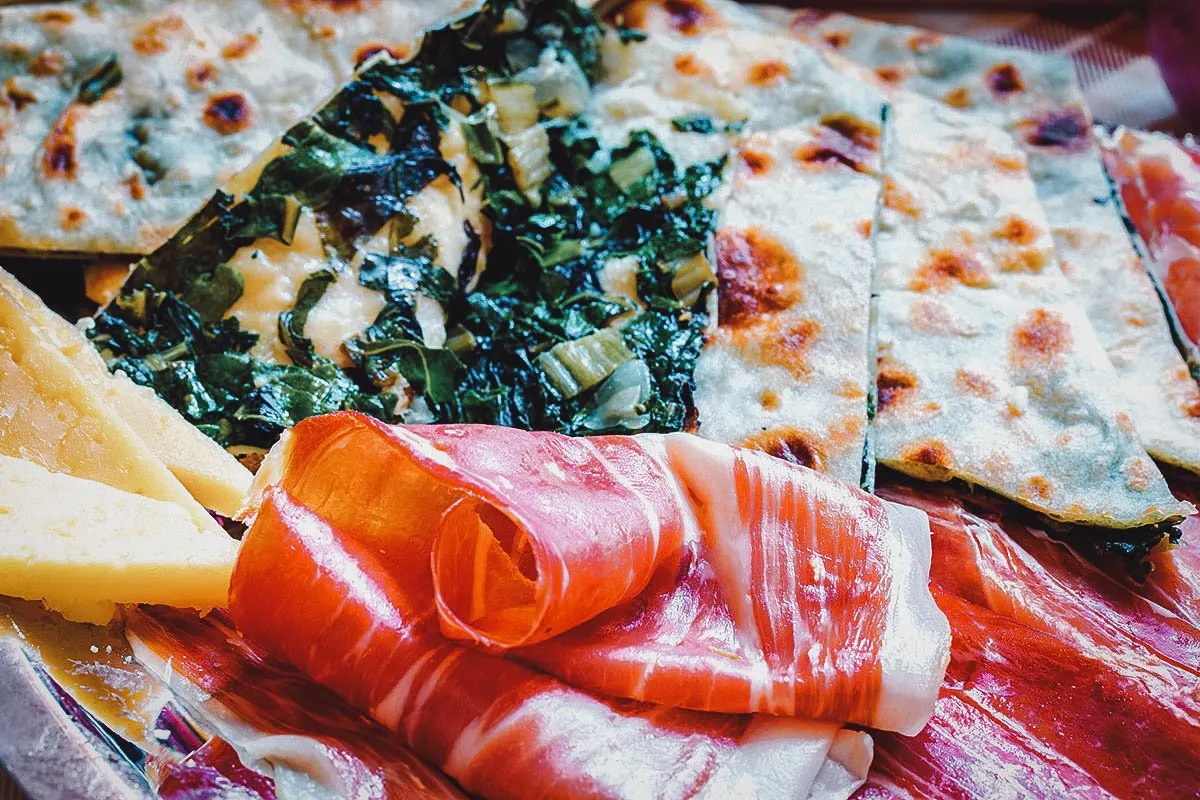
Photo by adrianam13
7. Bučnica
Bučnica refers to a type of Croatian savory strudel made with pumpkin, cottage cheese, sour cream, butter, and eggs wrapped in thin phyllo dough. It can be served warm or cold and is especially popular in and around the Croatian capital of Zagreb.
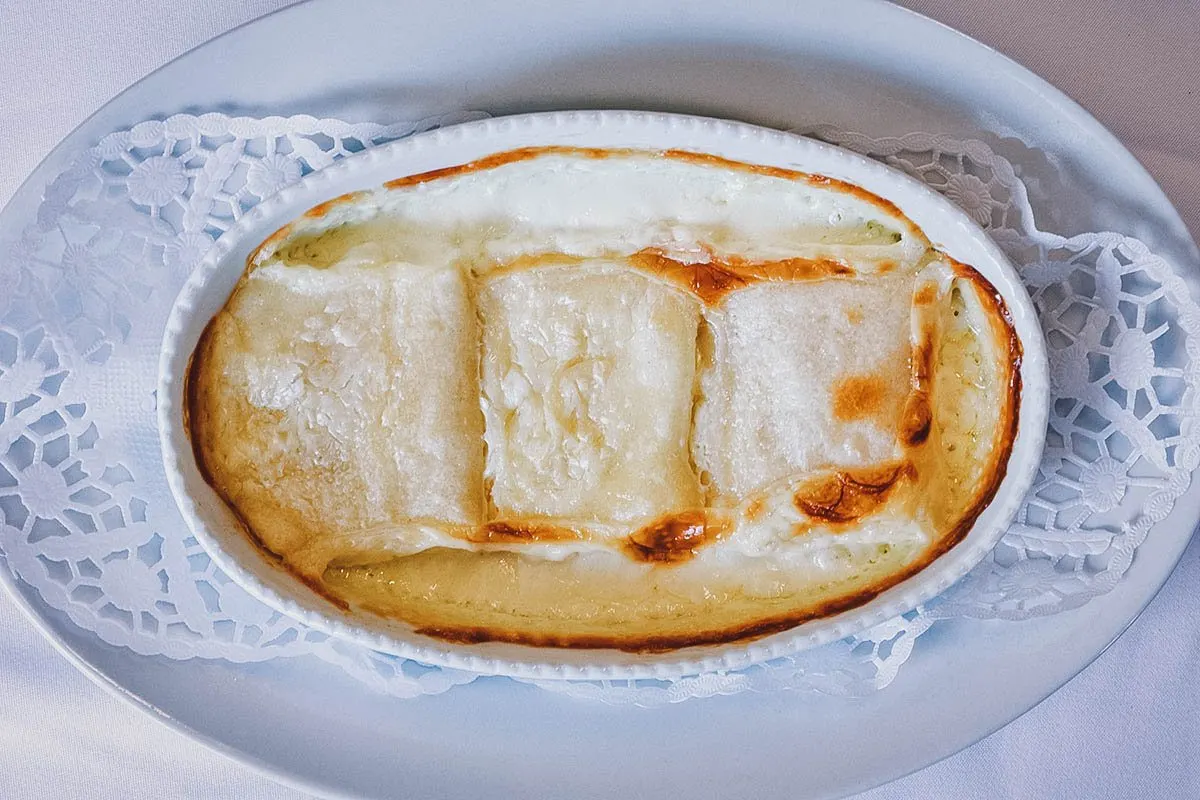
Photo by Wirestock
8. Punjena Paprika
Punjena paprika refers to a stuffed pepper dish that’s popular in many Balkan countries like Croatia, Albania, Bulgaria, Serbia, and Bosnia and Herzegovina. It’s also widely consumed throughout the South Caucasus, Central Asia, and the Levant.
Punjena paprika is a type of dolma – a family of stuffed dishes made with hollowed out vegetables filled with rice, meat, and other ingredients. Dolma can be made with any type of vegetable but punjena paprika is made specifically with stuffed peppers. In the Serbo-Croatian language, punjena paprika literally means “stuffed pepper”.
To prepare, the peppers are hollowed out and stuffed with a mixture consisting of minced meat (usually pork or beef), rice, egg, onions, garlic, herbs, and spices. Once stuffed, they’re cooked in tomato sauce and served with a side of mashed potatoes.
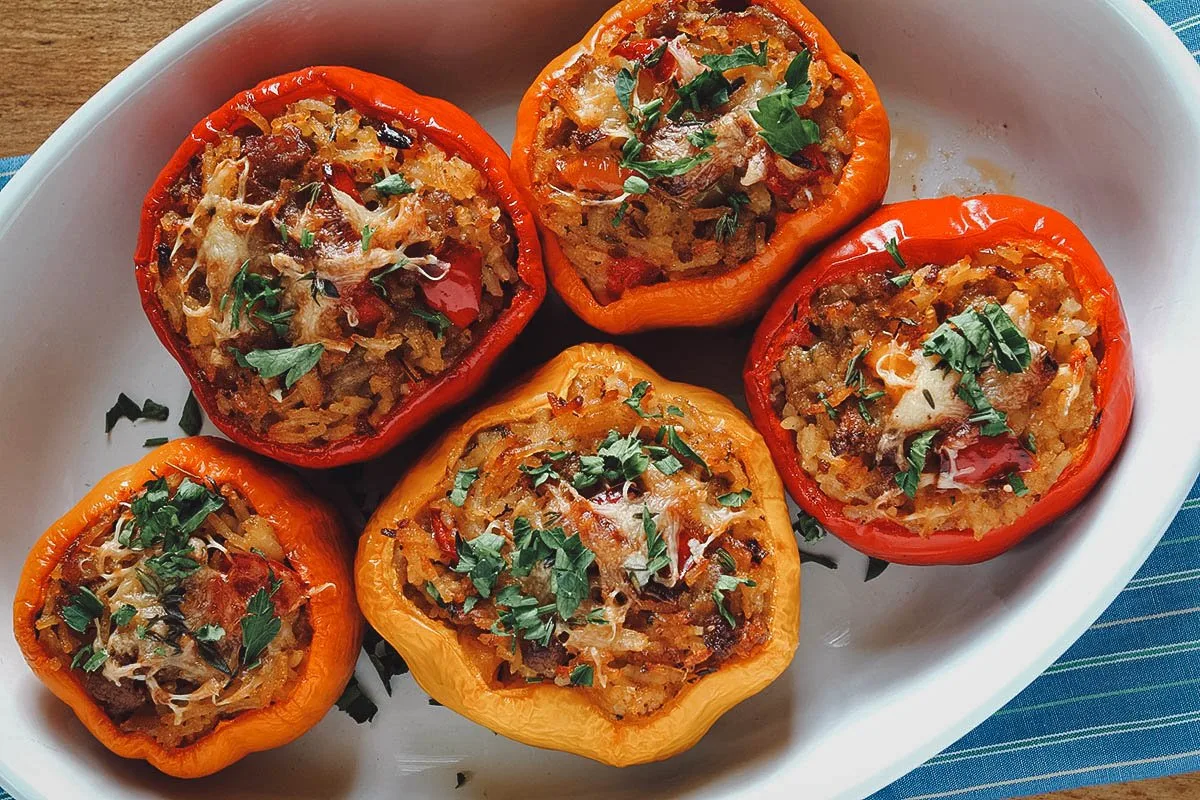
Photo by fotokris44
9. Sarma
Sarma refers to a stuffed vegetable dish that’s very similar to dolma. In fact, it can be considered a sub-type of dolma. It’s made with the same meat and rice filling but instead of being stuffed in hollowed-out vegetables, the filling is wrapped in cabbage leaves and then cooked with dry-smoked meat or bacon. Dolma means “stuffed” or “filled” while sarma means “rolled” or “wrapped”.
Sarma can be made with vine or Swiss chard leaves but the most popular version is made with pickled cabbage leaves. Unlike punjena paprika that’s typically consumed in the summer, sarma is more of a winter dish.
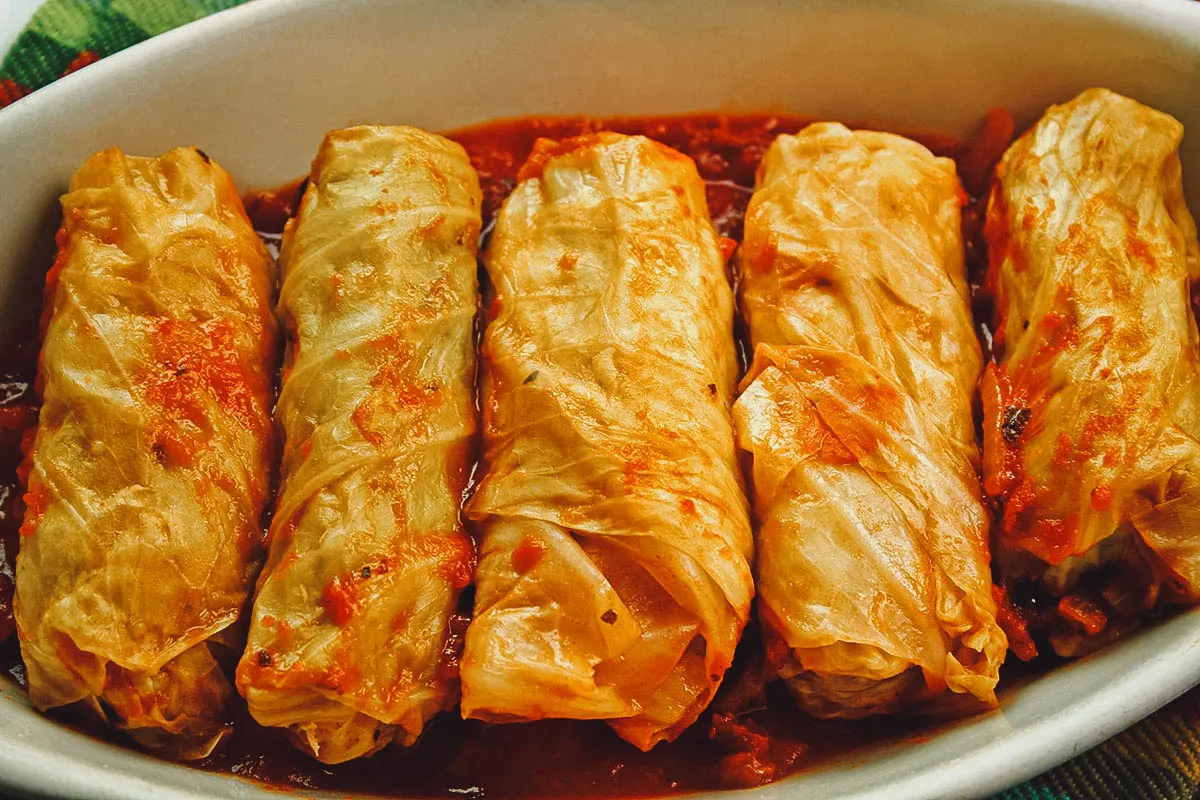
Photo by jabiru
10. Extra Virgin Olive Oil
Croatian olive oil is more an ingredient than an actual dish, but considering its quality and importance to traditional Croatian food, it’s more than worthy of a spot on this list. Italy and Spain may be more renowned but in the last fifteen years, Croatia’s Istria peninsula has made a name for itself as one of the world’s best producers of olive oil.
Many people may not realize this but Croatian producers make up 14% of the world’s finest olive oil, and a vast majority of that comes from Istria. Flos Olei – the first global extra virgin olive oil guide – named Istria the best olive oil producing region in the world for the sixth year in a row. Out of the 73 Croatian extra virgin olive oils that made it to the 2021 Flos Olei guide, 71 are from Istria.
Istrian olive oil is known for being high in polyphenols, the naturally-occurring micronutrients found in olive oil and other plant foods. The more polyphenols, the better-tasting the olive oil. Young olives have higher amounts of polyphenols so they’re harvested early to produce as high a grade of olive oil as possible.
If you visit Istria and are wondering what you can bring back as a souvenir, then look no further than a bottle of evoo. They’re sold in smaller quantities and are more expensive than your average bottle, but they’re worth every kuna.
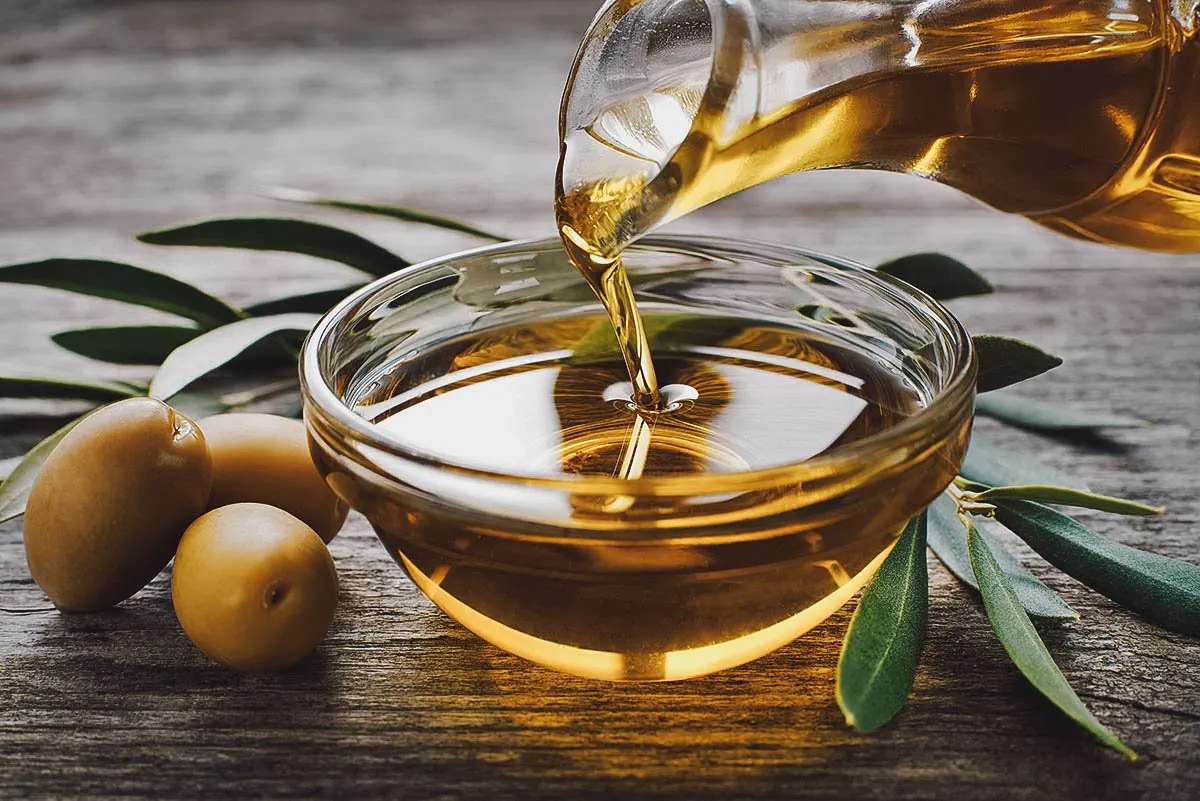
Photo by photodesign
SOUPS / STEWS
11. Brudet
No self-respecting guide on traditional Croatian food can ever be complete without brudet, the classic fish stew that’s considered by many to be a Croatian national dish.
Brudet refers to a traditional Croatian fish stew popular in the regions of Dalmatia, Istria, and Kvarner. Similar to the Italian brodetto or Greek bourdeto, it can be made with a variety of seafood and is considered a classic dish in Croatian cuisine.
Recipes for brudet vary but it’s typically made with at least three different types of fish that are cut into large chunks and left on the bone. Commonly used fish include forkbeard, conger, and monkfish in the traditional original brudet, though any type of white fish can be used. Other types of seafood like mussels and shrimp can be added to the stew as well.
To prepare, the different types of fish and seafood are stewed together in a pot with seafood stock, vegetables, tomato sauce, red or white wine, vinegar, and different Mediterranean herbs and spices like bay leaves, rosemary, and fresh parsley. Though no two recipes for brudet are alike, one thing remains constant – the dish is never to be stirred, only swirled by turning the pot.
Brudet is believed to be Venetian in origin and emerged sometime between the 14th and 16th centuries. It was likely invented by fishermen who made the stew using fish that were either damaged by fishing nets or had little to no commercial value.
At the time, the dish was regarded mostly as fisherman’s fare until the famous Italian Renaissance chef Bartolomeo Scappi declared: “No one can make a better fish stew than the fisherman of Venice”. Today, it’s consumed in many countries throughout the Adriatic coast like Italy, Croatia, Greece, and Montenegro.
In Croatia, brudet is traditionally served with polenta, boiled potatoes, or freshly baked bread. Several variations exist with some of the most well-known being brudet od liganja (squid) and brudet od morskog psa (shark). One of the most interesting and delicious has to be Neretvanski brudet. Hailing from the Neretva region, it’s a version of the classic fish stew made with the addition of eel and frogs.
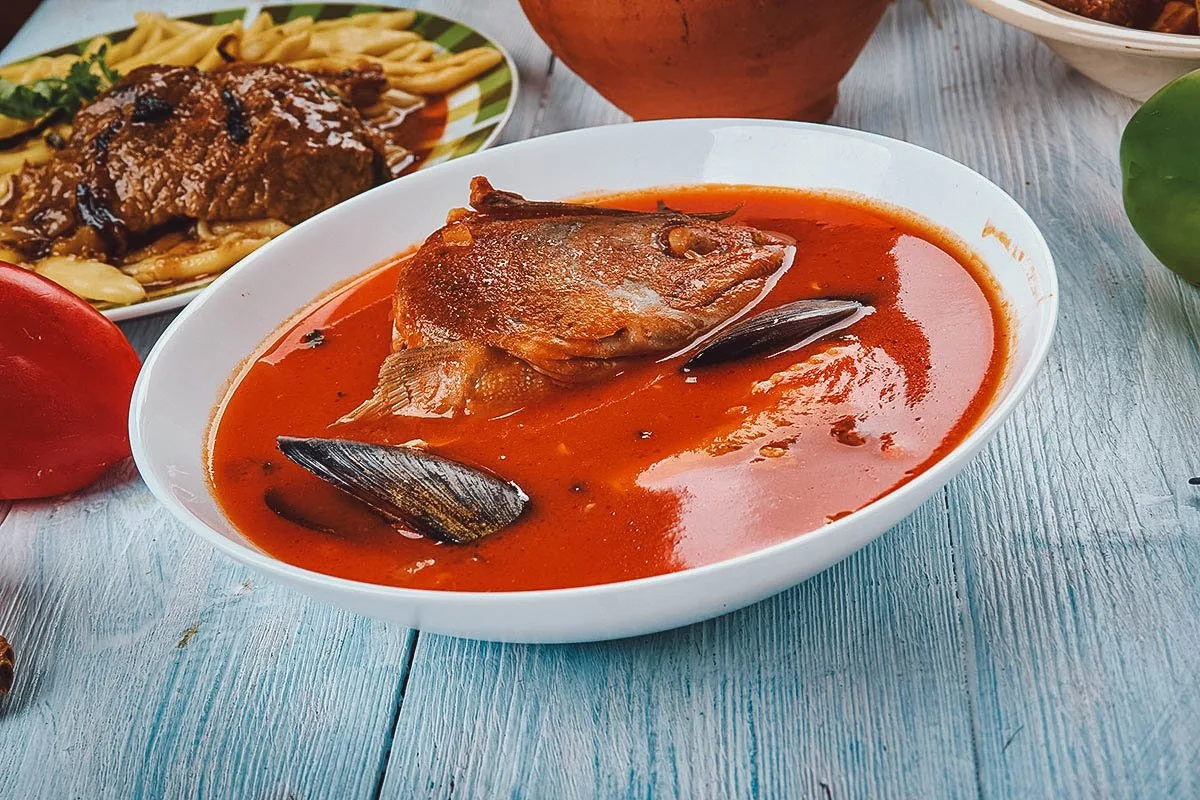
Photo by fanfon
12. Istarska Jota (Istrian Stew)
Istarska jota or Istrian stew refers to a traditional stew in Croatian cuisine. It’s consumed in parts of Slovenia and northeastern Italy, but it’s especially popular in Istria and northwestern Croatia where it’s considered by many to be a national dish.
Recipes for Istarska jota vary but it’s typically made with beans, sauerkraut or sour turnips, onions, garlic, potatoes, bacon, spare ribs, and olive oil. It’s a hearty and filling meal that was historically viewed as a type of poor man’s food.
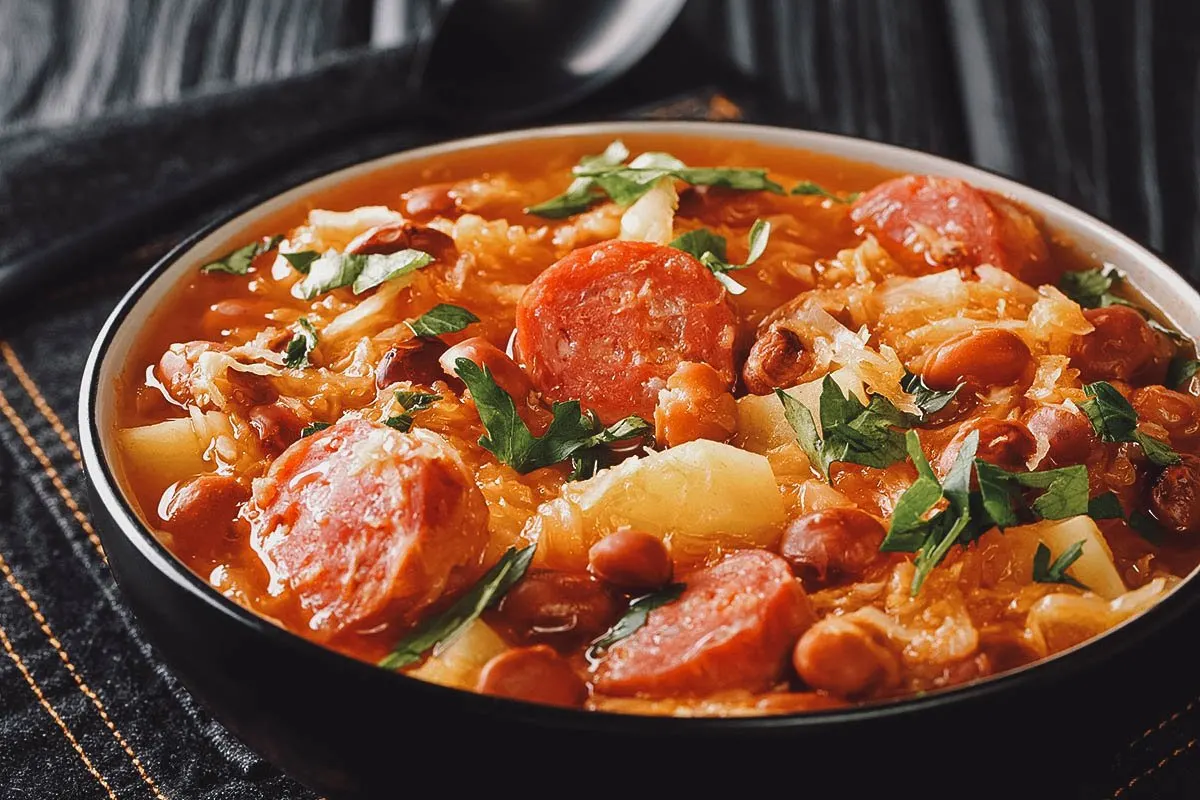
Photo by lenyvavsha
13. Ričet
Ričet (or jačmik) is a type of thick barley-based soup or stew popular in the cuisines of Croatia, Slovenia, Austria, and Bavaria. It’s made with a good amount of cured pork stewed with different vegetables and starchy ingredients like beans, potatoes, pot barley, carrots, onions, tomatoes, garlic, celery, and leeks.
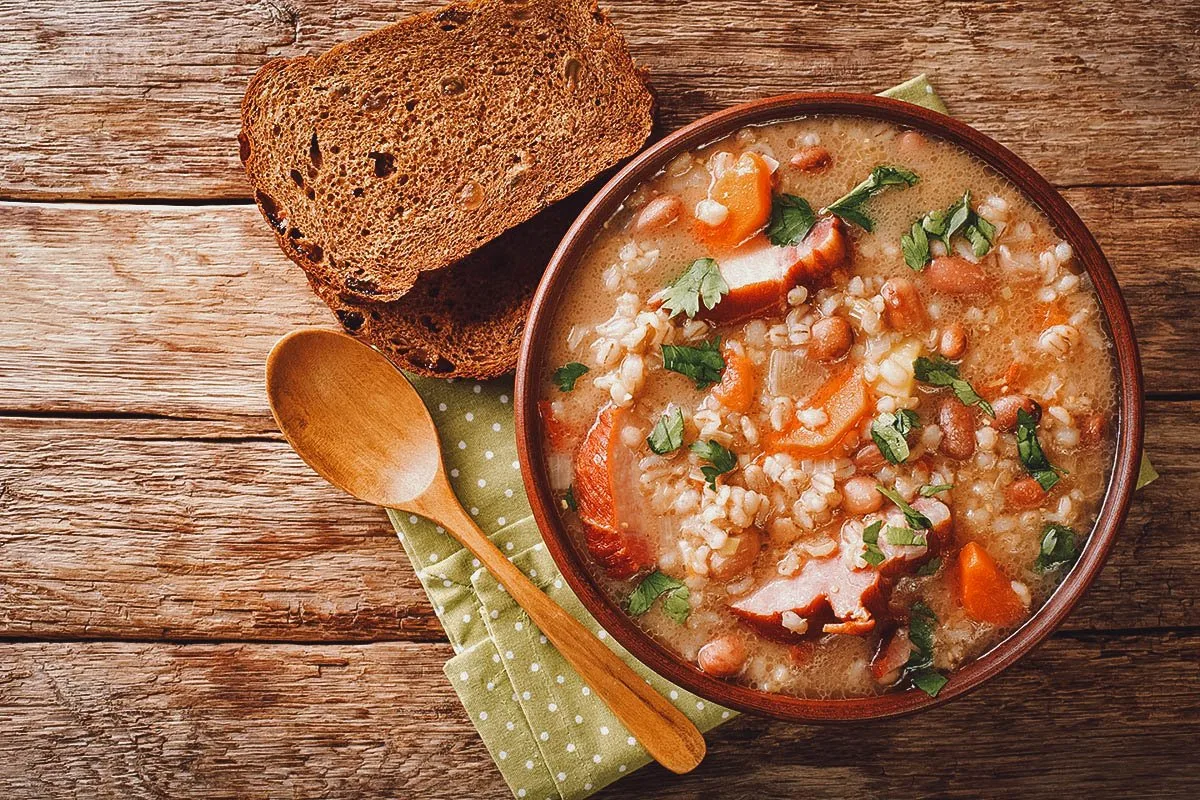
Photo by lenyvavsha
14. Maneštra
This thick and hearty stew from Istria is the Croatian take on Italian minestrone. It exists in many variations though it’s typically made with dried meat, beans, and corn seasoned with bay leaves, black pepper, parsley, and olive oil.
When made with just vegetables like carrots, onions, celery, and tomatoes, maneštra is typically served as a starter. But when it contains more substantial ingredients like meat, it can be enjoyed as a main course with a side of crusty Croatian bread.
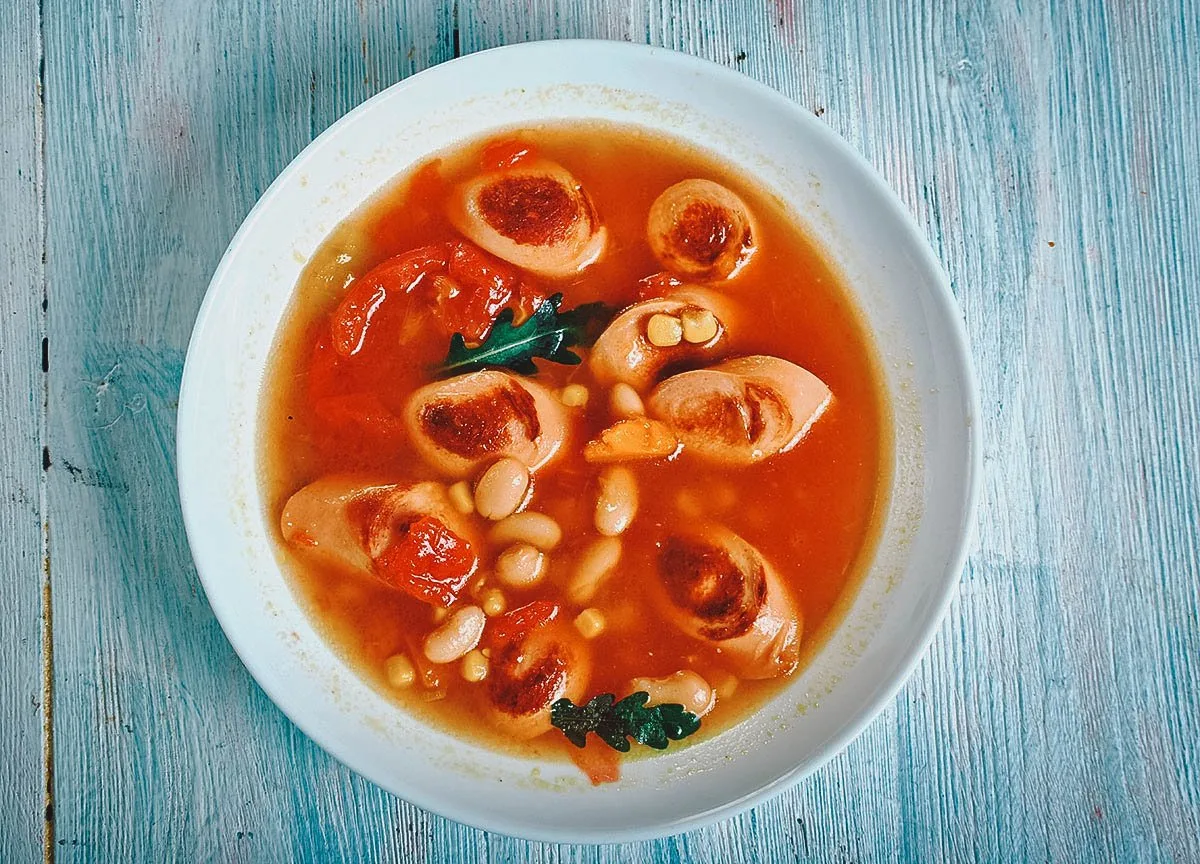
Photo by fanfon
15. Grah
Going through this Croatian food guide, it becomes clear that beans are a key ingredient in many traditional Croatian dishes. Hearty bean soups and stews feature prominently in the Croatian diet and grah is another example of that.
Grah refers to a thick Croatian bean soup made with a variety of beans, smoked sausages, smoked meats, onions, garlic, tomato puree, and bay leaves. Any type of dried bean can be used though pinto, kidney, or cranberry beans are the most common.
Grah can be enjoyed at any time of the year though it’s especially popular in winter. It’s a thick and substantial meal that’s often enjoyed as a main course, usually with crusty Croatian bread.
In Primorje, Dalmatia, and Istria, a version of grah made with pasta called pašta fažol is a must-try.
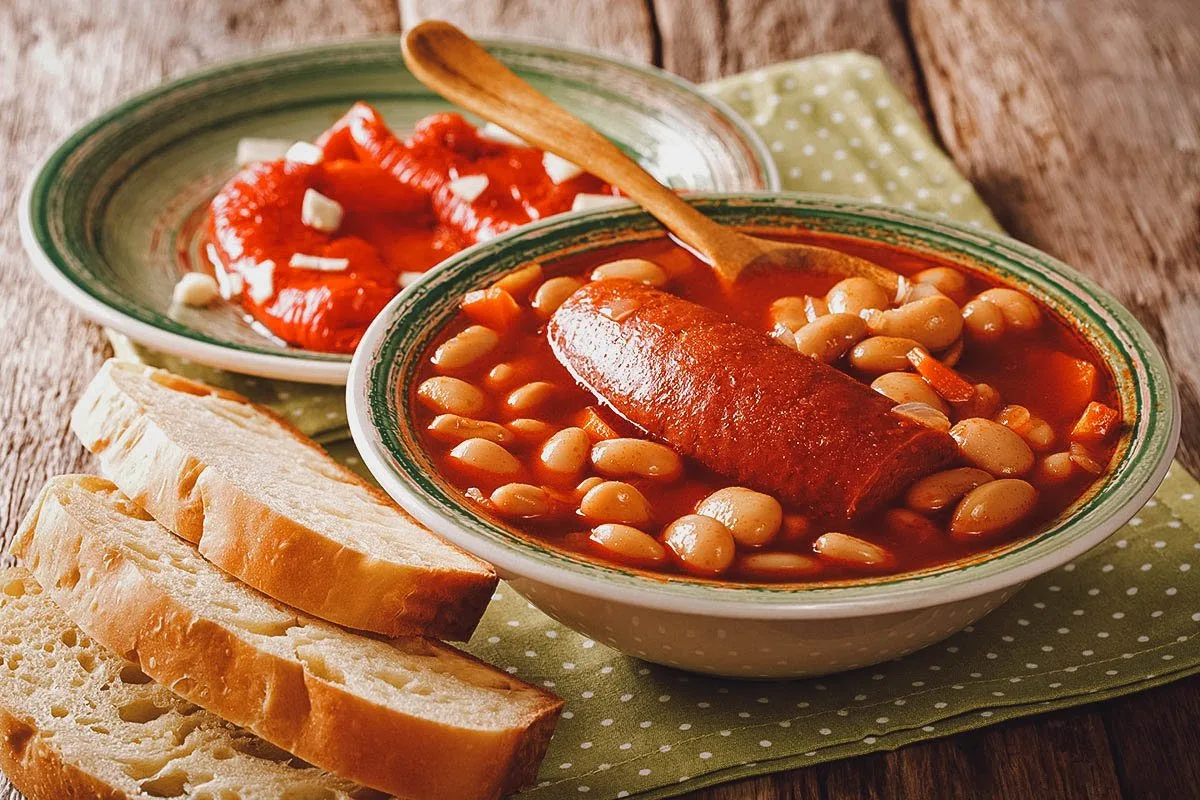
Photo by lenyvavsha
16. Sataraš
Sataraš refers to a light vegetable stew made with bell peppers, onions, garlic, and tomatoes. Similar to Hungarian lecsó, it’s popular throughout the Balkans and can be enjoyed as a main dish with rice or mashed potatoes, or as a side dish with grilled meats, pasta, polenta, or eggs.
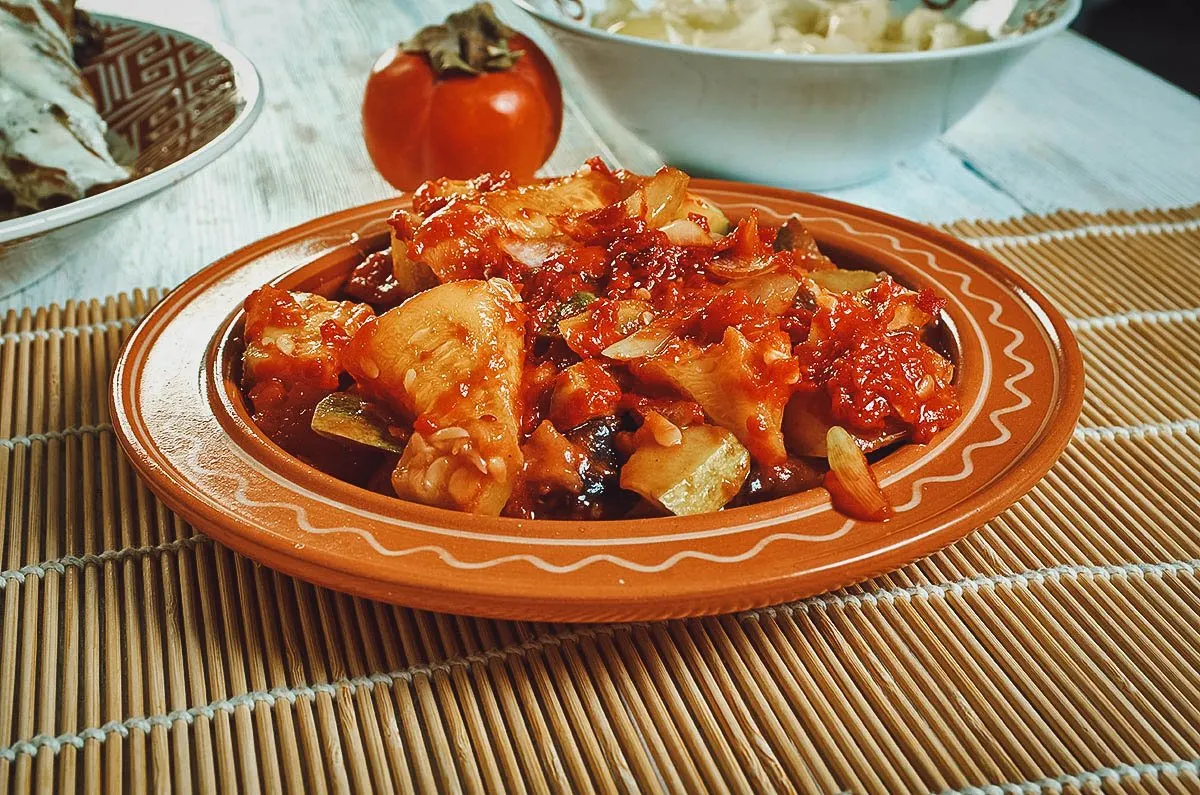
Photo by fanfon
BREAD / PASTRIES
17. Burek
Burek is perhaps one of the most controversial dishes in this Croatian food guide. It’s controversial for two reasons. One, the contents of a true burek are often up for debate, and two, it’s widely consumed throughout the Balkans and is claimed by many countries.
Burek (or börek, byrek, boureki, burekas) refers to a family of baked filled pastries made with various ingredients stuffed in a thin and flaky yufka or phyllo dough. It’s typically filled with meat or cottage cheese though it can also be made with other ingredients like spinach and potatoes. For purists, only burek filled with meat can be called a true burek. Everything else is just a savory pie.
The exact origins of burek are unclear but it’s widely believed to have originated from the kitchens of the Ottoman empire. It spread throughout the region and has now become an important part of the cuisines of many countries in the Balkans, the South Caucasus, Central Asia, and the Levant.
Burek can take many forms depending on where it’s from. It can be made into round pies or baked in long rolled versions that are coiled up into a circle. It can be large and cut into smaller portions or made into individual pastries.
No matter what shape it takes or what it’s made with, burek is an absolutely delicious dish and a must-try in Croatia.

Photo by OlgaIlinich
18. Zagorski Štrukli
No self-respecting Croatian food guide can ever be complete without mentioning Zagorski štrukli, a traditional pastry dish that’s widely consumed in the Zagreb and Hrvatsko Zagorje regions of northern Croatia. It’s a simple dish that can be salty or sweet and enjoyed as an appetizer, snack, main dish, or dessert.
Zagorski štrukli (or Zagorje štrukli) is made with a dough that’s rolled out thinly and filled with cottage cheese, butter, eggs, and sour cream. When made as a dessert, sugar is added. The stuffed dough is then rolled and cut into rectangles before being baked or boiled in salted water. When baked, štrukli is typically poured over with cream while boiled versions are often sprinkled with breadcrumbs and served in Croatian soups.
Pictured below is a dessert version of štrukli lightly dusted with powdered sugar. Whether savory or sweet, boiled or baked, Zagorski štrukli is considered a national dish of Croatia. It was added to Croatia’s intangible cultural heritage list by the Ministry of Culture in 2007.
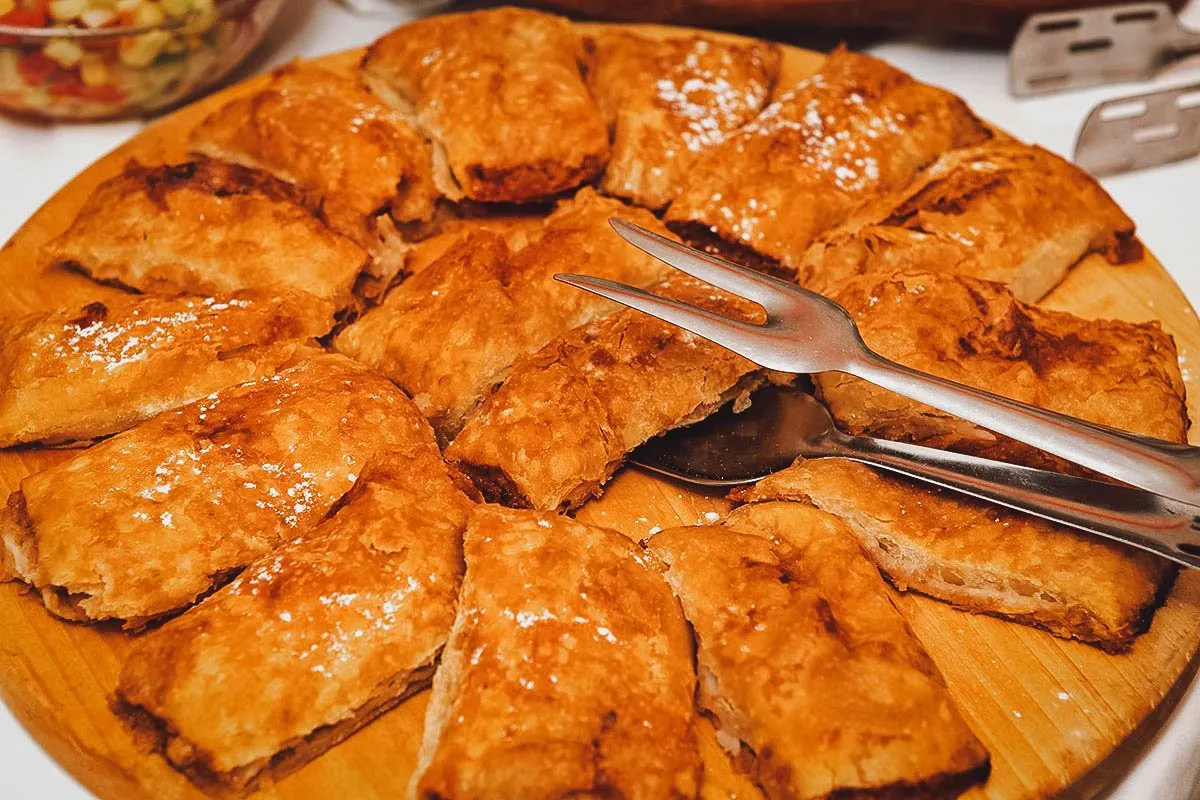
Photo by gsermek
19. Pinca
Like Thanksgiving in the US, Easter is the most important holiday in Croatian culture, even more important than Christmas. It’s the one time in the year when Croatian families get together to pray and celebrate. Many dishes make it to the Croatian Easter table but none are more important than pinca.
Pinca (or sirnica) is a traditional Croatian Easter bread or sweet roll. It’s believed to have its origins in the Venetian Republic where it was viewed as rich man’s food. Back then, cakes and sweets were a luxury and consumed only by people wealthy enough to afford them. Today, pinca is consumed by all social classes and often made at home.
Recipes vary from family to family but it’s typically made with a rich yeast dough containing lots of butter and eggs, lemon zest, candied fruit, dried fruit, rum, and prošek (Croatian dessert wine). The dough is shaped into a round loaf and carved with the sign of the cross on its surface. It’s then brushed with egg wash and sprinkled with sugar and chopped almonds and hazelnuts before being baked in an oven.
Pinca is usually prepared a few days before Easter and brought to church on Holy Saturday to receive a blessing. It’s served on Easter Sunday for breakfast or as a snack, often with coffee or tea.
Pinca is such an important part of the Croatian Easter tradition that according to one Croatian food blogger, not having pinca on the Easter table is like not having Easter at all.
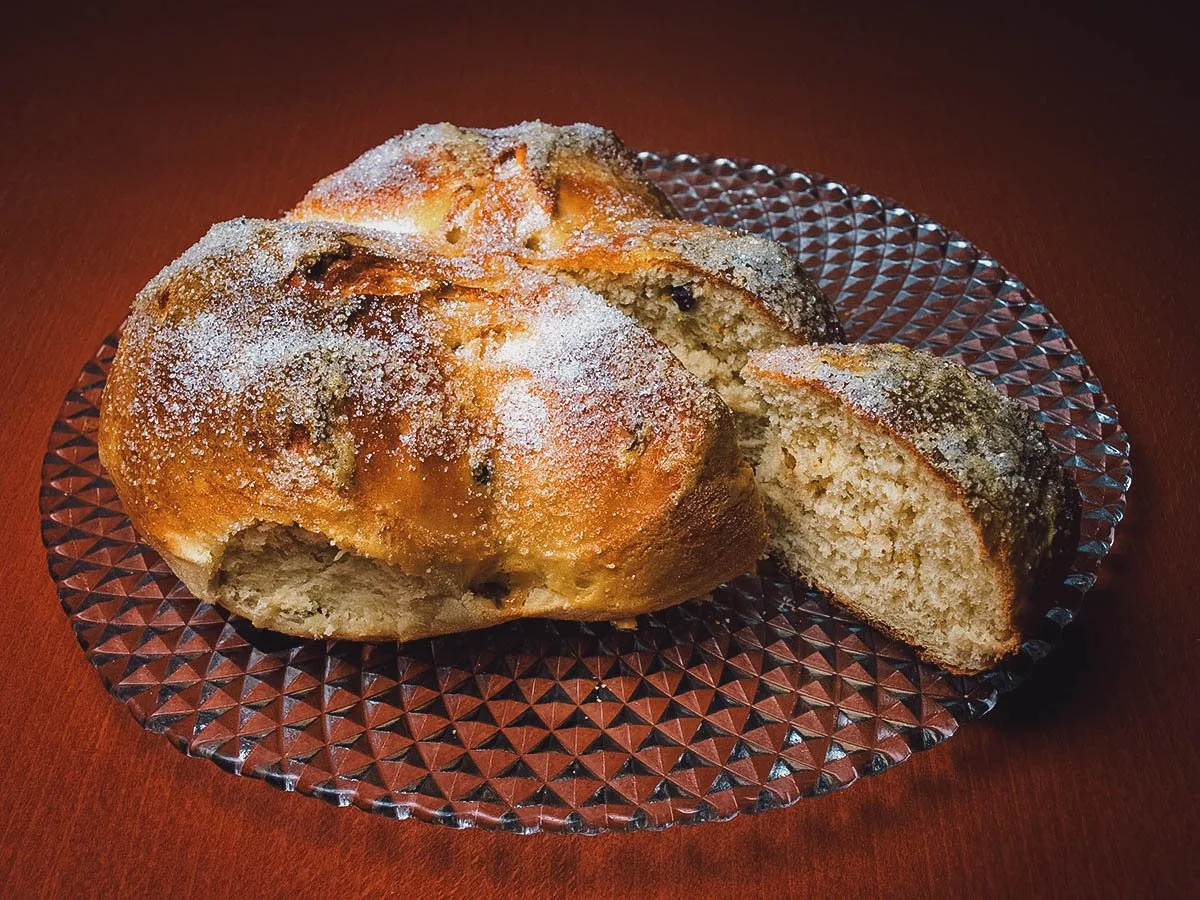
Photo by sbotas
20. Pogača
Pogača is a type of bread that’s popular in many Balkan countries like Croatia, Serbia, North Macedonia, and Turkey. It’s similar to Italian focaccia in texture and flavor and can be made in different shapes and sizes, though round is most common.
There are as many recipes for pogača as there are Croatian cooks but it’s commonly made with white or whole wheat flour. Traditionally, the bread is served plain but it can be stuffed with a variety of fillings as well like potatoes, cabbage, onions, tomatoes, ground beef, anchovies, or goat cheese. Various herbs and seeds like sesame, dill, and black nigella are often mixed into the dough and sprinkled on top.
The islands of Vis and Hvar in the Dalmatian region are particularly known for their pogača, producing well-known bread pies like Komiža pogača, Viška pogača, and Forska pogača.
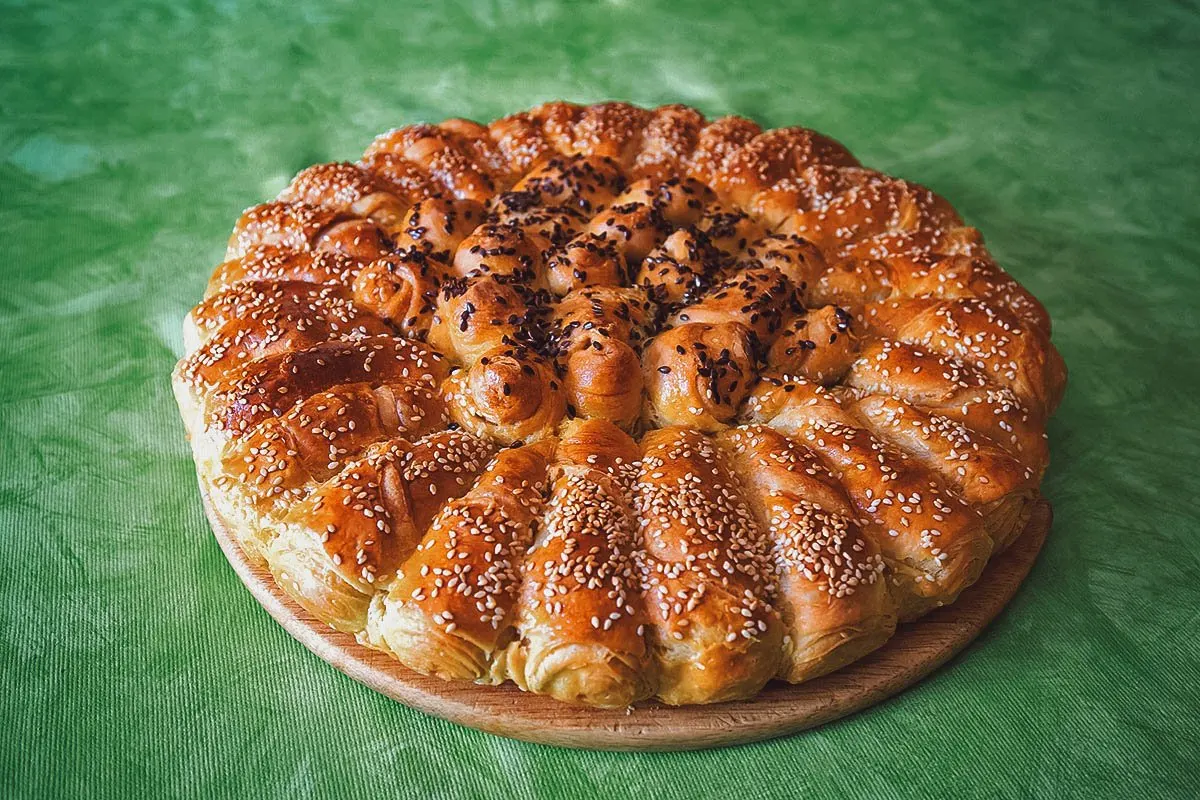
Photo by xbrchx
MEAT / SEAFOOD
21. Kulen / Kulenova Seka
One of the things we enjoy most about food travel is sampling all the different sausages we encounter on our trips. In Croatia, the one sausage that you definitely shouldn’t miss is kulen. The king of all Croatian sausages, it’s a national dish and the most famous delicacy from the Eastern Croatian region of Slavonia.
Kulen refers to a type of Croatian pork sausage flavored with paprika and garlic. It’s known for its piquant flavor and strong smoky aroma derived from months of smoking prior to air drying.
Like many heritage foods, strict rules apply when preparing kulen. It can only be made with meat from free-range pigs raised in Slavonia, the most common being the black Slavonian pig and Mangulica. They’re left to roam the Slavonian forests to feed on a diet consisting mostly of acorns, organic corn, and barley. This specialized diet is what gives kulen its signature flavor.
Once the pigs reach an adult weight of over 180 kg (397 lbs), they’re ready for slaughter. The best cuts of pork are chopped by hand and cleaned of all fatty and connective tissue before being seasoned with paprika, garlic, and salt.
The mixture is then stuffed into different natural casings and smoked for several months over beechwood before being air-dried. When stuffed into smaller, thinner casings, it becomes known as kulenova seka. The process typically starts between November and March and can last for several months, sometimes up to a year.
In Slavonia, kulen is typically consumed during Easter though it’s often a part of many holiday spreads. It’s best paired with a mildly flavored cheese and a lighter Croatian red wine.
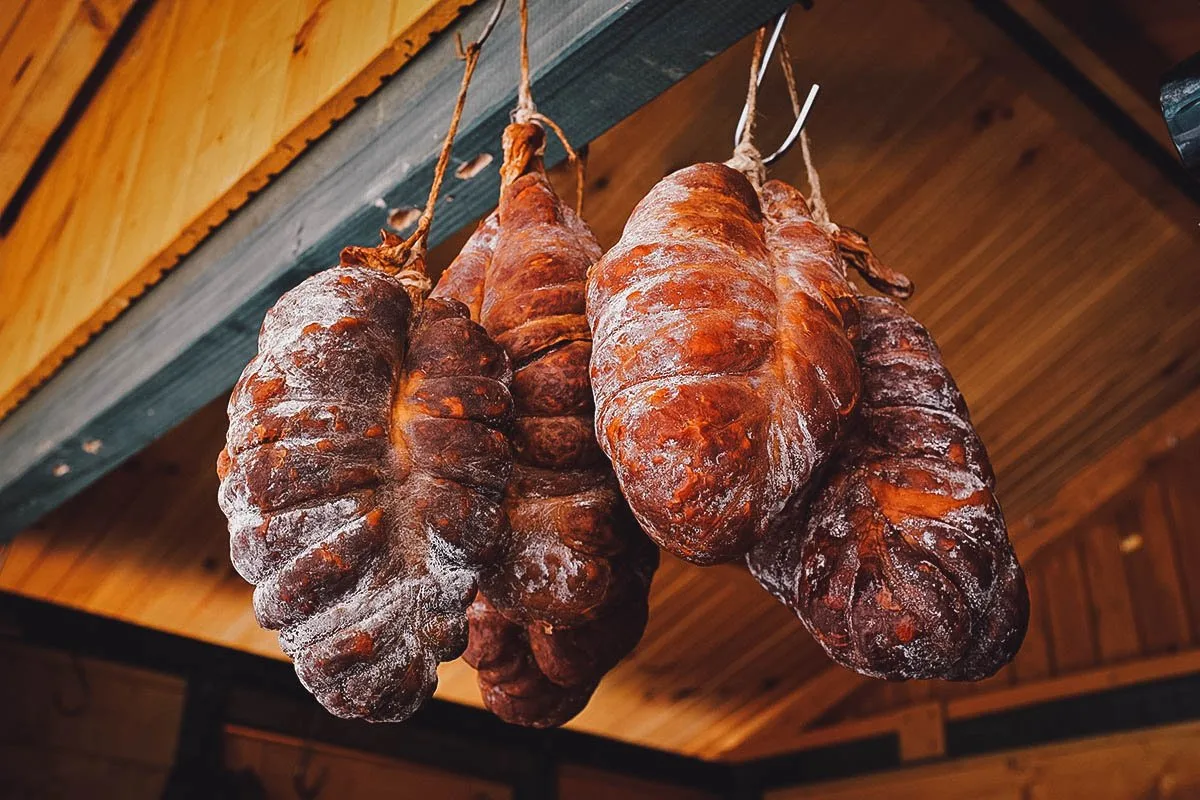
Photo by viki2win
22. Češnjovka
If sampling one type of Croatian sausage isn’t enough for you, then be sure to try češnjovka as well. It refers to a slightly spicy pork sausage made with copious amounts of garlic.
Češnjovka is popular in central and northern Croatia, especially in the city of Samobor where it’s considered a delicacy. It’s best paired with red wine and a locally produced mustard called Samoborska muštarda.
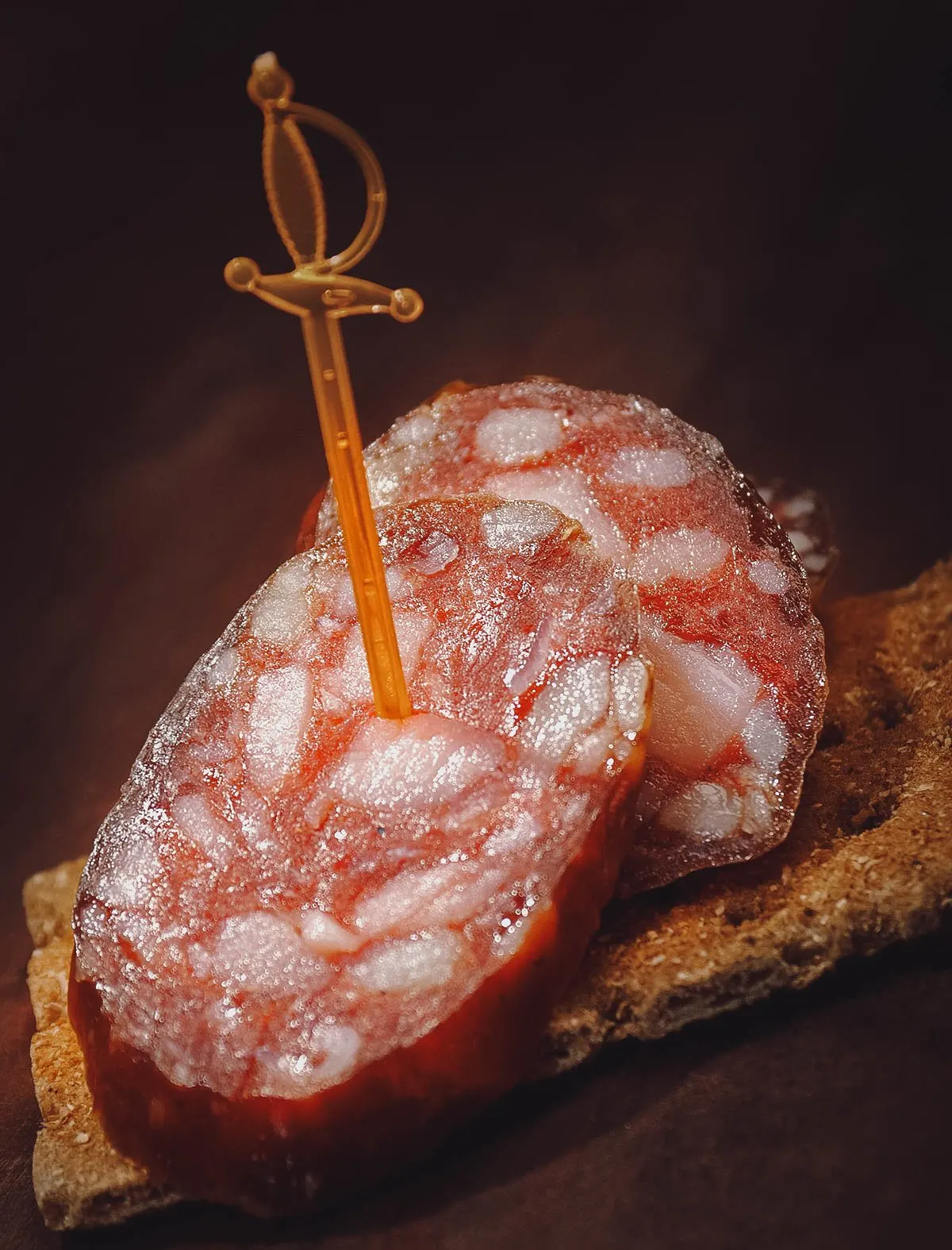
Photo by fanfon
23. Dalmatinski Pršut
Dalmatinski pršut is one of the most famous regional foods in Croatia. A specialty of the Dalmatian region, it’s a type of dry-cured Croatian prosciutto made from pork legs that have been wood-smoked and air-dried for at least twelve months.
To make pršut, the fresh thighs of specially fattened pigs are rubbed with a generous amount of fine and coarse sea salt. They’re then left for at least a week to allow any remaining blood and water to be drained before being salted again. The legs are then hung on hooks and smoked in a room using wood from beech, oak, or hornbeam trees.
After smoking, the pork legs are left to dry and mature in the air for at least a month. The strong cold and dry bura wind naturally dries out the meat and helps give the meat its desired firmness and texture. When ready, the pršut is cut into thin slices and best paired with homemade bread, cheese, and Croatian wine.
If you want the very best Croatian pršut, then be sure to try Drniški pršut. It’s a type of Croatian prosciutto made in the town of Drniš in inland Dalmatia. Produced in the region since the 14th century, it’s made with premium quality pork thighs that are cold-smoked and dried for a minimum of twelve months.
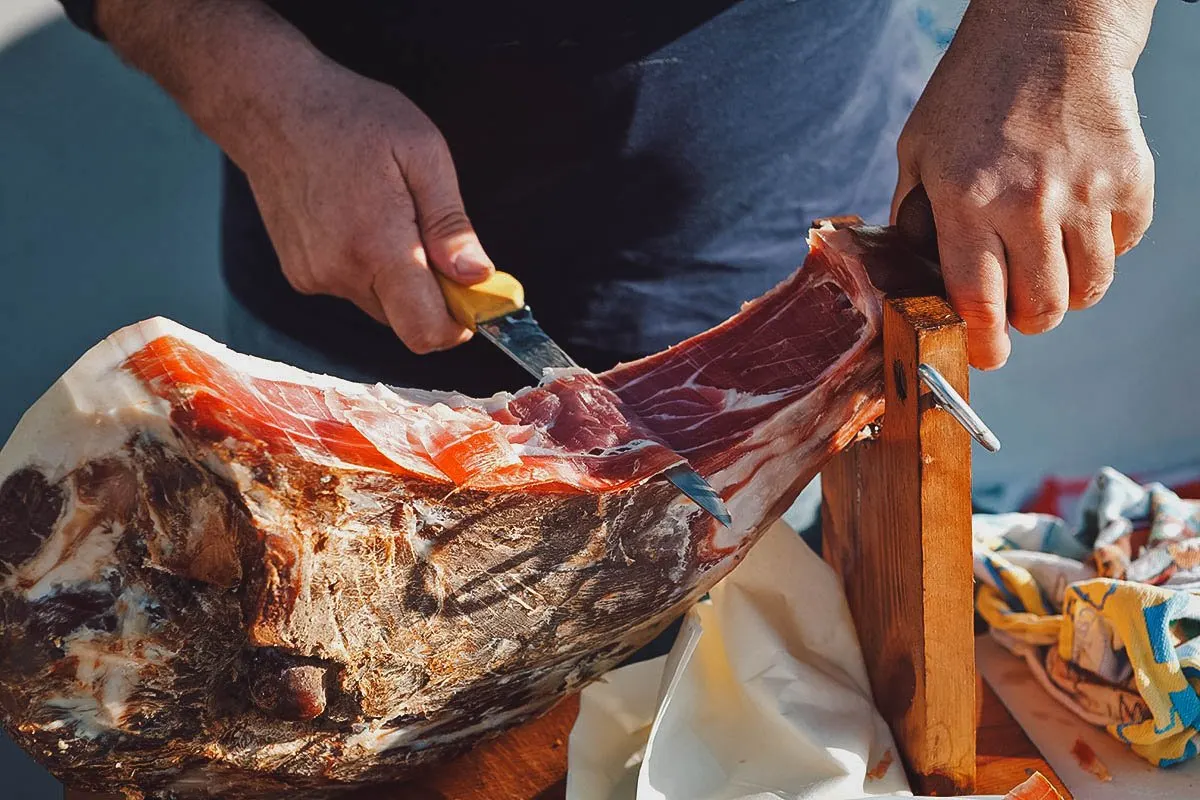
Photo by gsermek
24. Pašticada
Like pršut, pašticada (or Dalmatinska pašticada) is one of the most famous regional foods in Croatia. It refers to a traditional Dalmatian dish made with braised beef cooked in red wine with bacon, tomatoes, dried fruit, and root vegetables.
To prepare, a whole round steak is pierced and stuffed with garlic, cloves, bacon, and carrots before being marinated in vinegar and spices for up to two days. It’s then seared and stewed for several hours in red wine or prošek with onions, tomato paste, parsley root, celery root, dried prunes, dried figs, herbs, and spices.
Typically requiring about two to three days to make, pašticada is a time-consuming dish that’s usually prepared for important celebratory feasts like weddings and baptisms. It’s often served with a side of njoki and homemade pasta.
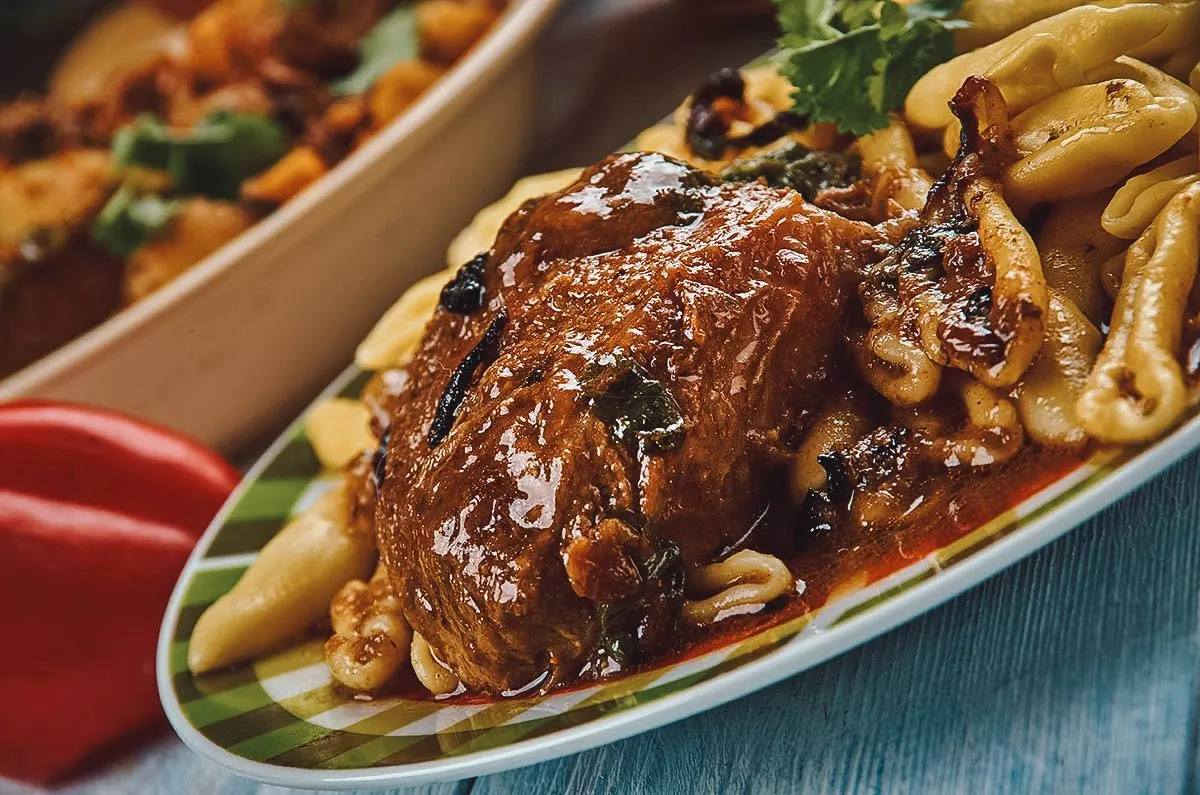
Photo by fanfon
25. Ćevapčići
This heavily seasoned grilled meat dish is one of the most popular foods in the Balkans. It’s widely consumed in Croatia, Montenegro, Kosovo, North Macedonia, Slovenia, and Albania and is considered a national dish in Serbia and Bosnia and Herzegovina.
Ćevapčići (or ćevapi) is a type of Balkan meatball shaped like small cigars. Recipes vary from region to region but it’s typically made with a mixture of different types of meat like beef, pork, mutton, and lamb seasoned with garlic, onions, paprika, and parsley.
A popular comfort food in Croatia, ćevapčići is usually served in groups of five to ten pieces on a plate or in flatbread sandwiches (lepinja) with onions, ajvar, and kajmak (fermented clotted cream).
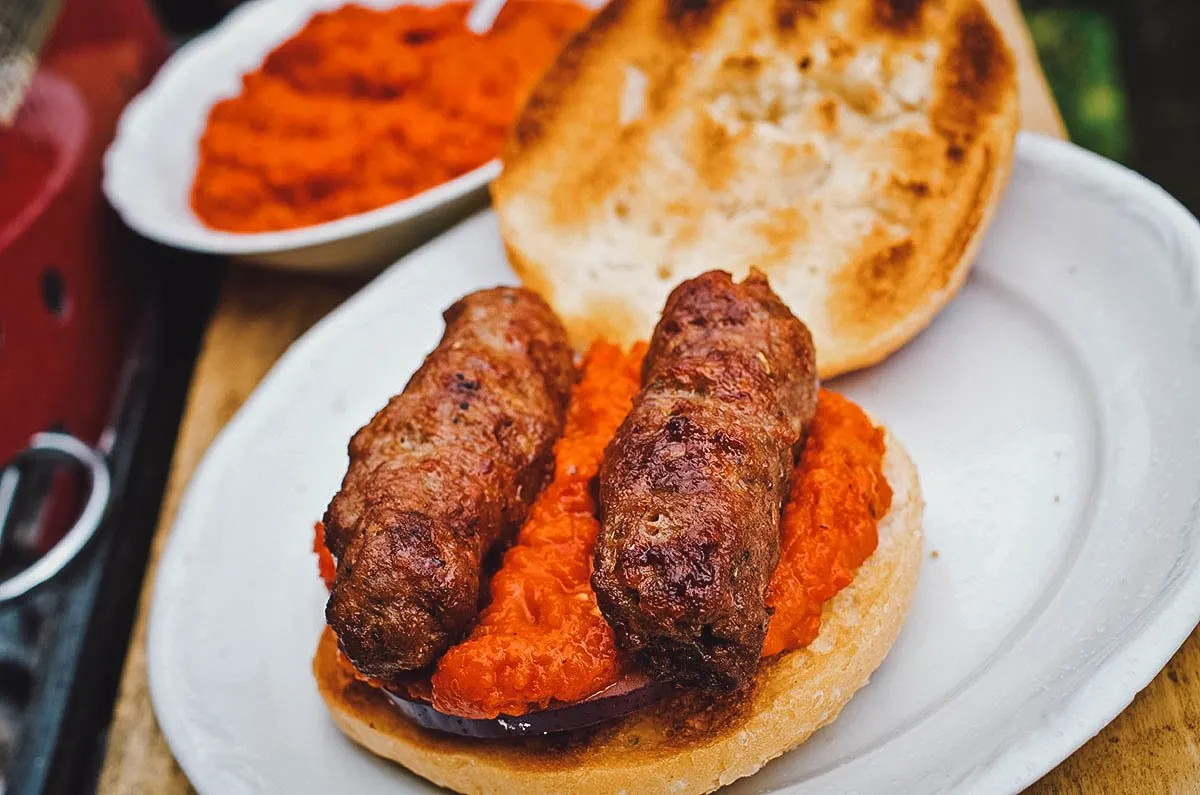
Photo by ccat82
26. Kotlovina
If you like meat dishes, then you’re going to love kotlovina, a traditional dish from the northwestern region of Croatia. It’s made with different types of meat, sausages, vegetables, and potatoes cooked outdoors on a specially designed stove.
In Croatian, kotao means “cauldron” so the term kotlovina can refer to both the dish and the cooking vessel used to make it. Less a cauldron than a type of outdoor stove, a kotlovina consists of a large metal pan with an indented center that’s placed on a pedestal with a compartment for wood or charcoal.
To prepare, different cuts of fatty pork are fried with sliced onions before being doused with water and wine to create a basic stock. Once cooked, they’re moved to the edge of the pan so other meats, sausages, potatoes, vegetables, beans, and mushrooms can be stewed in the middle. The ingredients are slowly cooked to make them as tender and as flavorful as possible.
Because it can be made with any number of ingredients, side dishes are often unnecessary, though Croatian bread dumplings do make for a welcome accompaniment to any kotlovina.
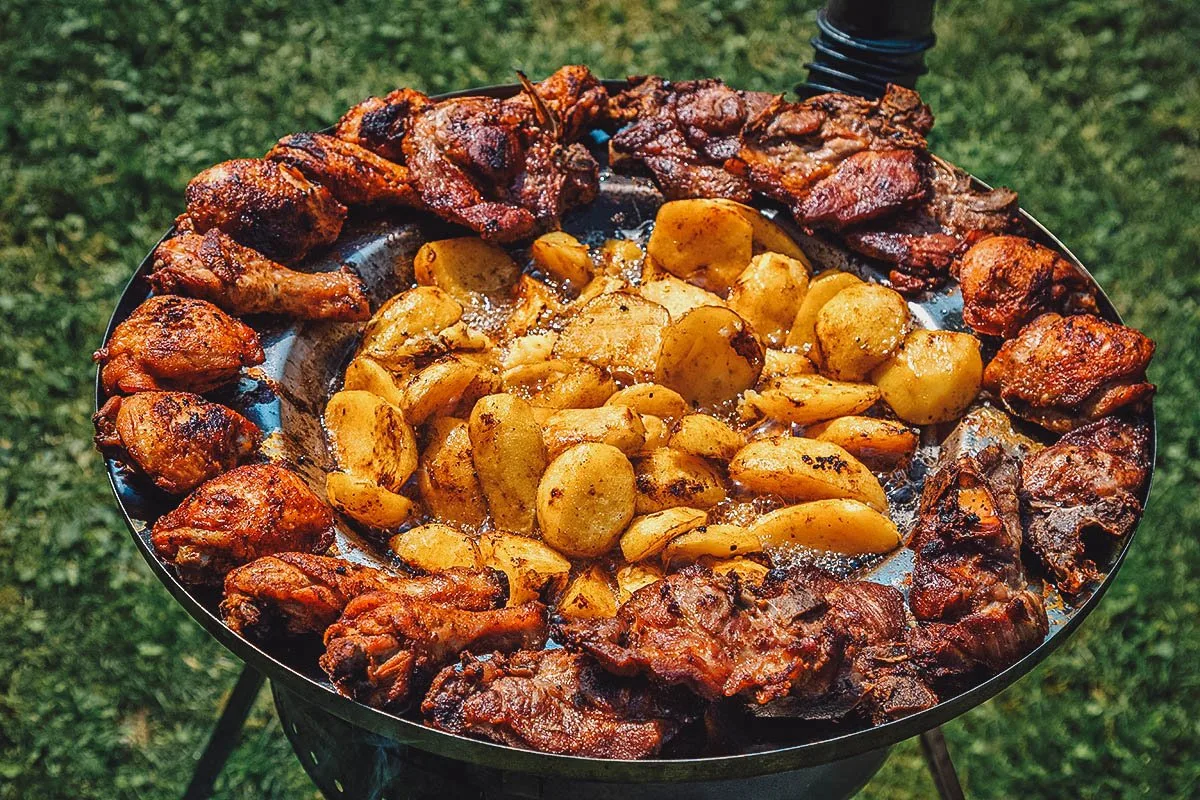
Photo by kataklinger
27. Peka
This next entry isn’t exactly a dish, but a cooking device that’s used to prepare a variety of seafood, meat, and vegetable dishes.
Popular in Croatia and Bosnia and Herzegovina, a peka (or sač) is a cooking vessel with a bell-shaped lid made from cast iron or clay. Like a kotlovina, it’s used outdoors to cook a variety of dishes over an open fire and with hot charcoal placed over the lid (see next picture).
This dual heat course, together with the shape of the vessel, allows steam to recirculate so dishes are cooked slowly and more evenly. You can think of it as a primitive type of convection oven that also allows dishes to be lightly smoked.
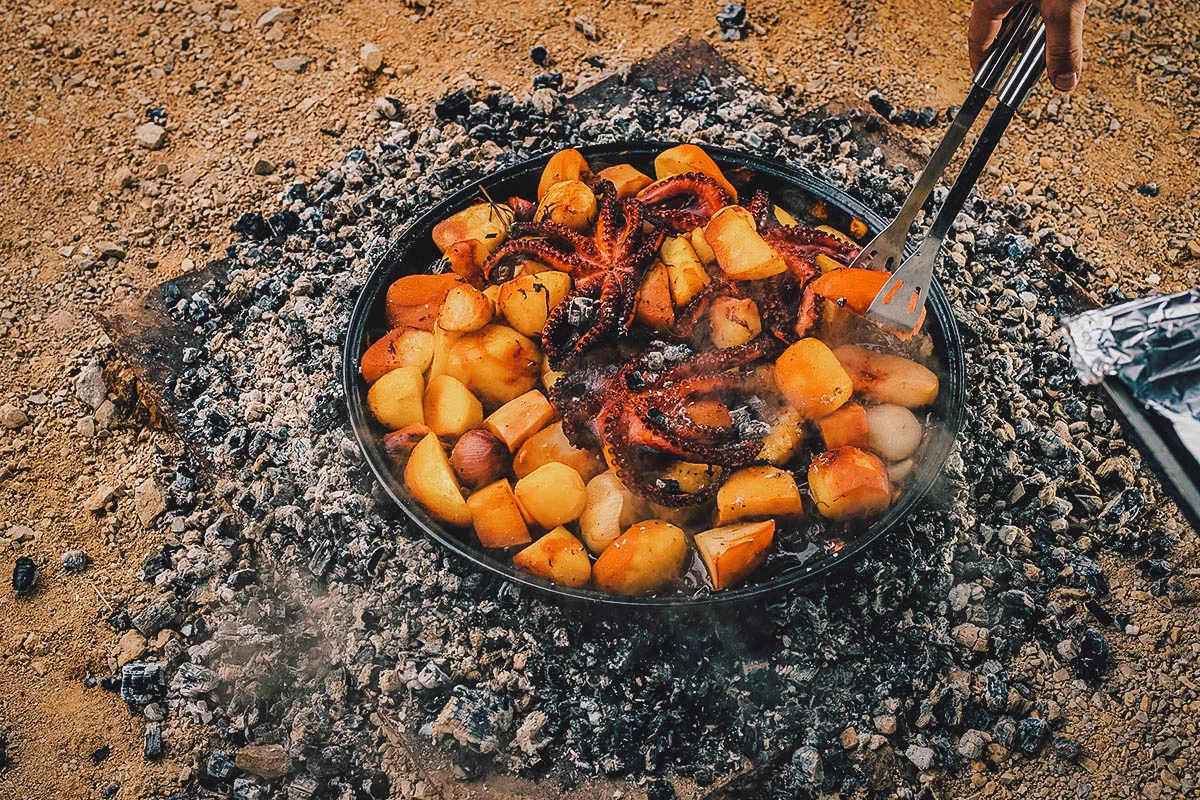
Photo by psgt_123
Here’s a look at the peka’s lid covered in hot coals. Note the ring that keeps the embers in place. It’s believed that the peka was invented as an inexpensive option for people who couldn’t afford ovens.
The peka is often used in Dalmatia to cook many dishes like roasted lamb, veal, and octopus. It can even be used to bake bread and traditional pastries like burek, either on top of the lid or inside the vessel.
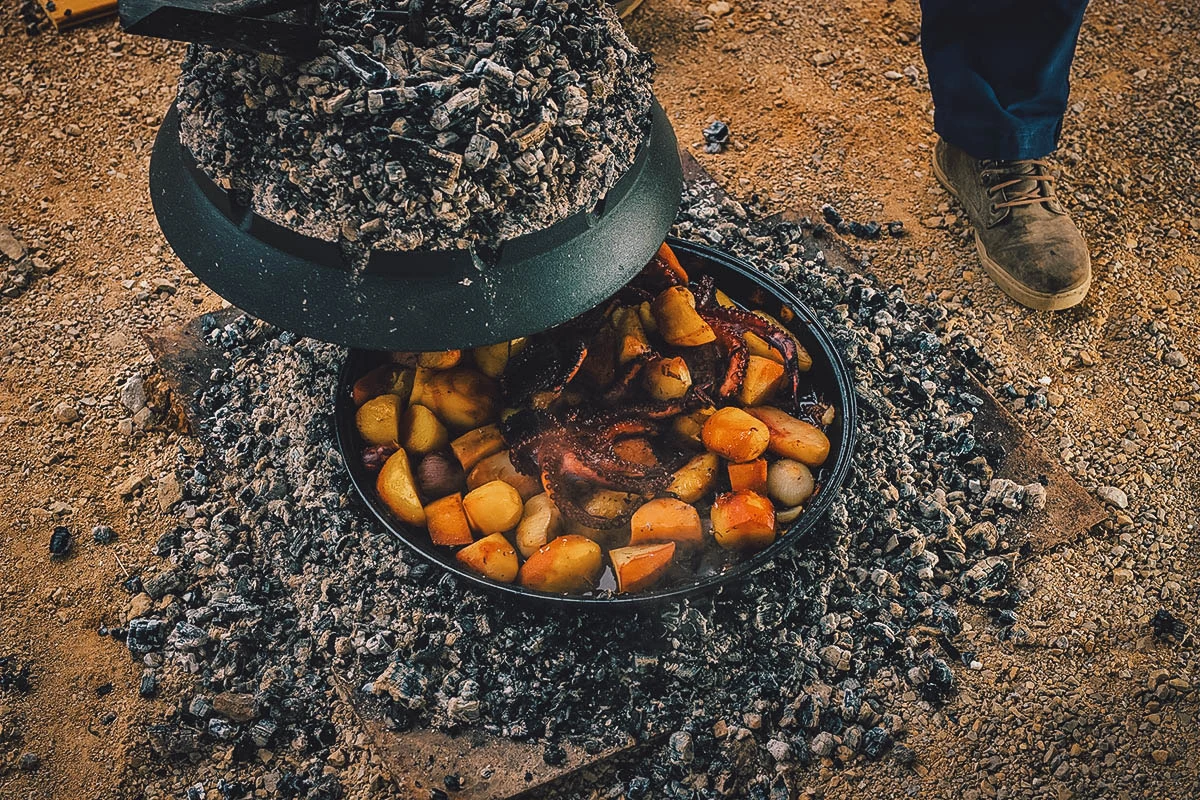
Photo by psgt_123
28. Šestinska Pečenica
Popular in Zagreb, šestinska pečenica refers to a Croatian meat dish made with cubes of skewered pork cooked on a grill. The meat is typically seasoned only with salt and served with a side of raw onions and ajvar, a widely used Balkan condiment made with roasted bell peppers, eggplant, and olive oil.
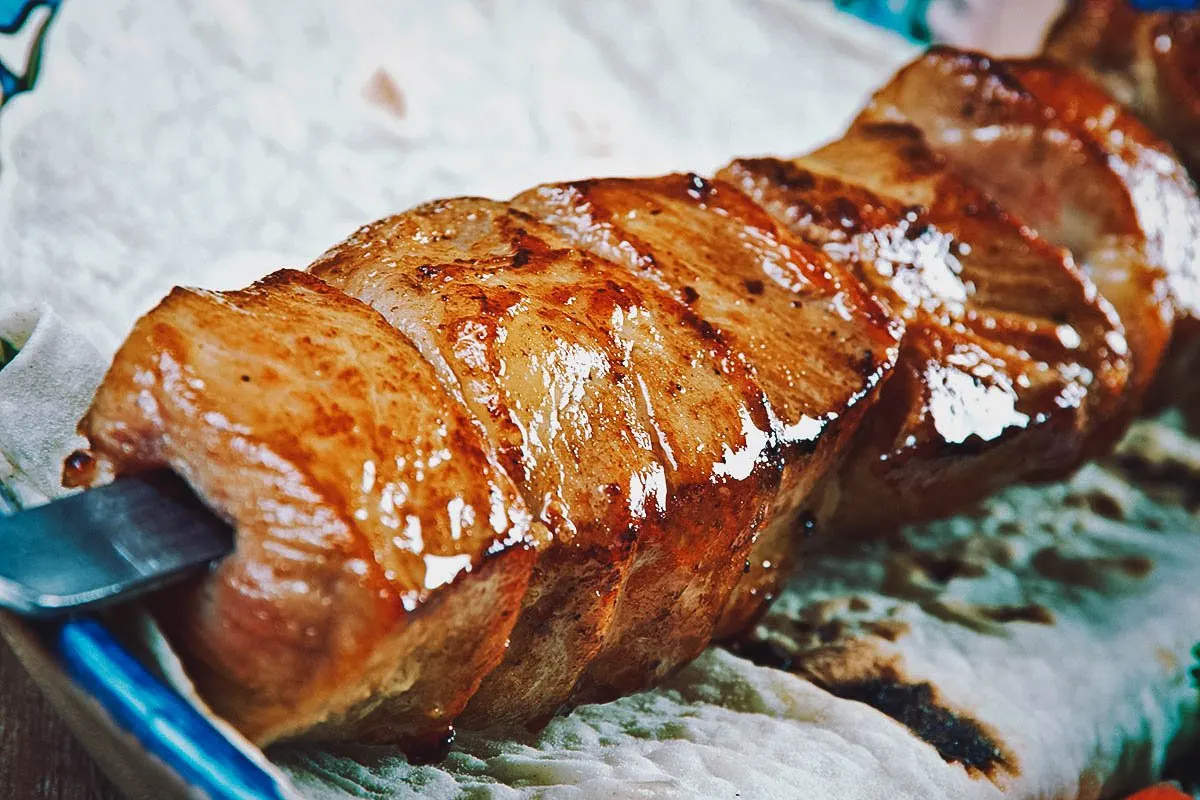
Photo by fanfon
29. Zagrebački Odrezak
As its name suggests, zagrebački odrezak is a Croatian dish popular in Zagreb. Also known as the Zagreb schnitzel, it refers to a pan-fried veal escalope filled with ham and melted cheese. It’s essentially the Croatian equivalent to the Austrian wiener schnitzel or the Swiss cordon bleu.
Zagrebački odrezak is typically made with veal though it can be made with pork, chicken, or turkey meat as well. To prepare, a slice of veal is hammered till tender and thin before being filled with cooked ham and cheese. The stuffed veal is rolled in flour, eggs, and breadcrumbs and then pan-fried to a crisp golden brown.
The Zagreb schnitzel is a common sight on Croatian restaurant menus and is often served with a side of french fries or risotto with peas. Be sure to give it a spritz of lemon juice to cut the richness of the fried ham and melted cheese.
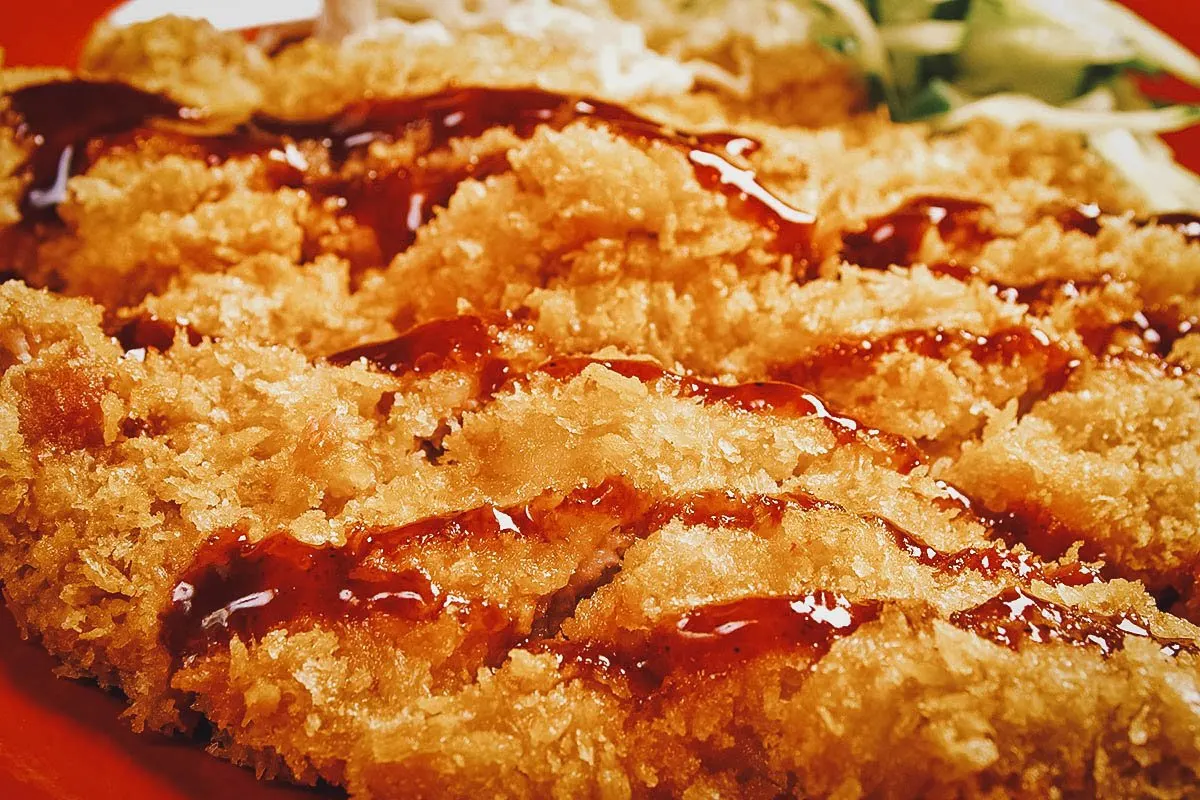
Photo by fanfon
30. Seafood
With almost 5,800 km (3,600 mi) worth of coastline, it’s no coincidence that fresh seafood figures prominently in the Croatian diet. The Adriatic Sea borders the entire western side of Croatia and has had a significant influence on the country’s cuisine.
Common seafood dishes like fresh oysters, mussels, grilled fish, scampi, and octopus salad are plentiful but be sure to try more unique local fare like brudet, black risotto, and octopus peka as well.
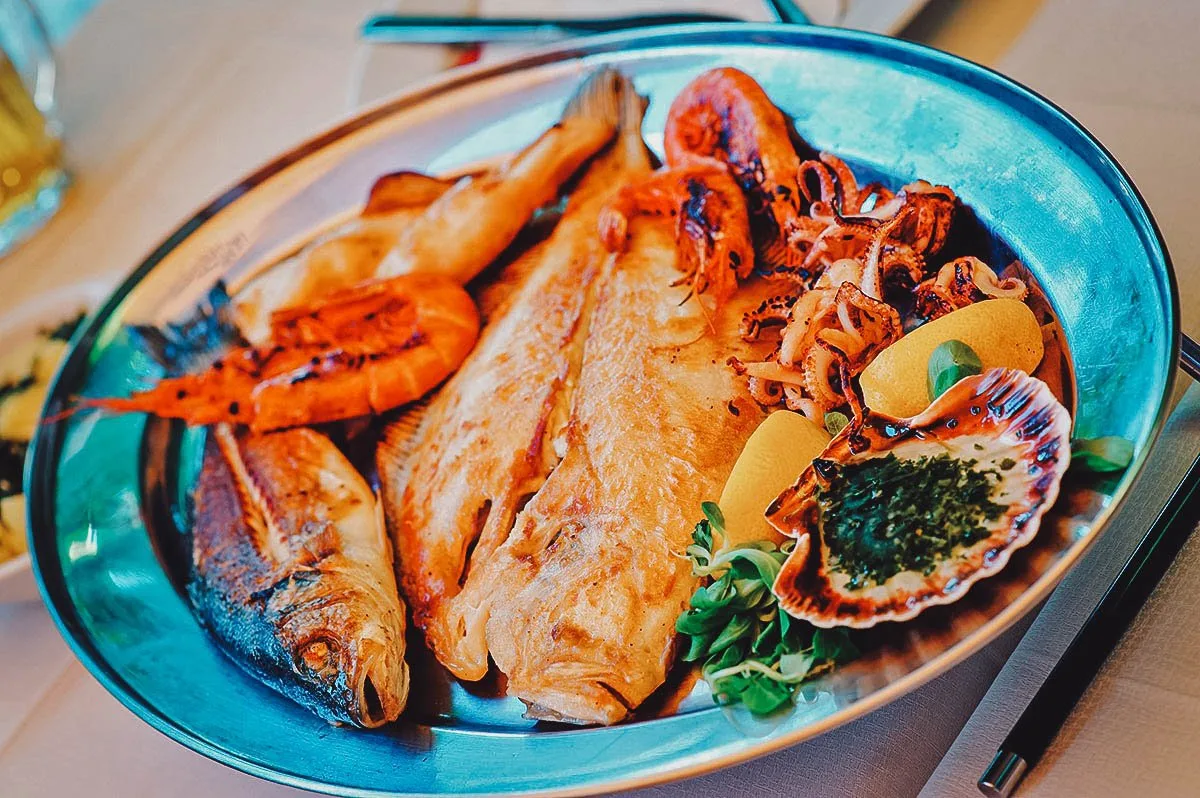
Photo by mashiki
If you have a taste for squid ink like I do, then you’re going to love crni rižot or black risotto. A staple dish in Dalmatia, it consists of risotto cooked with squid or cuttlefish. Like paella negra of Spanish cuisine, the black risotto gets its color from cuttlefish or squid ink.
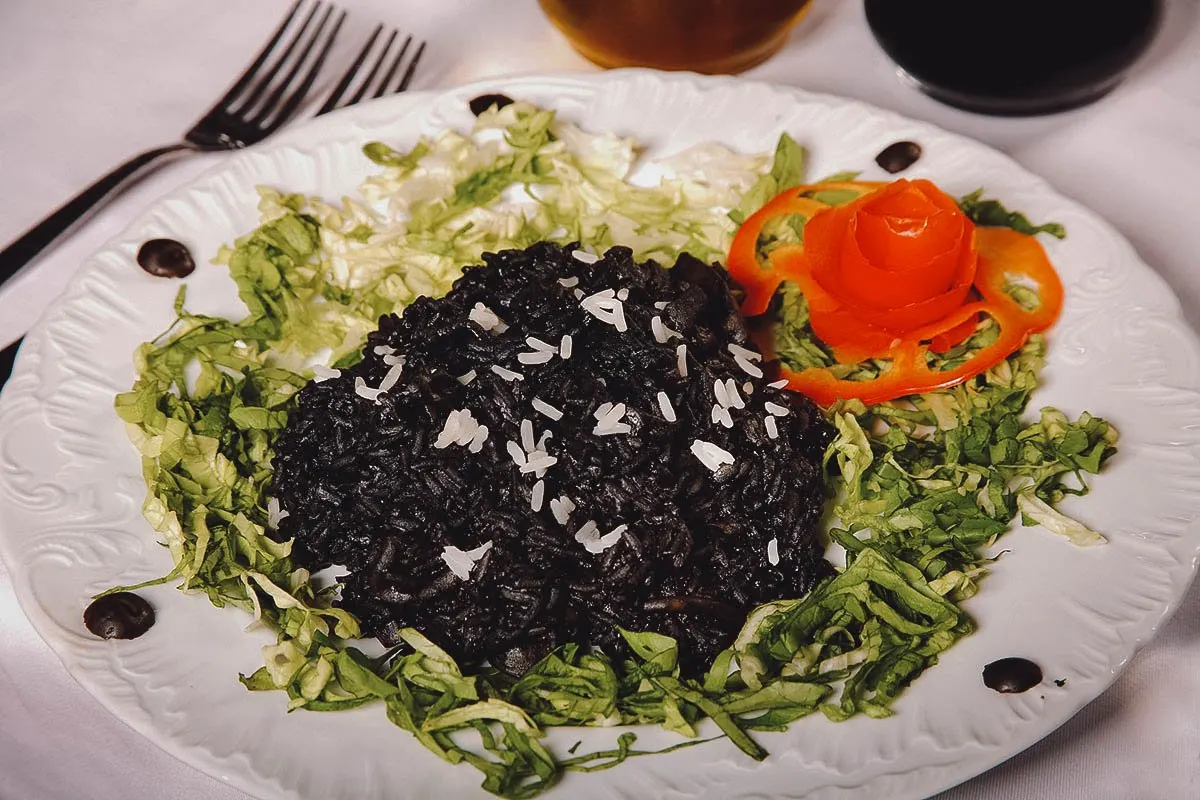
Photo by Nikodash
Grilled Adriatic squid is a typical – though by no means ordinary – Croatian meal that consists of small, very lightly grilled squid. They can be prepared with or without the ink.
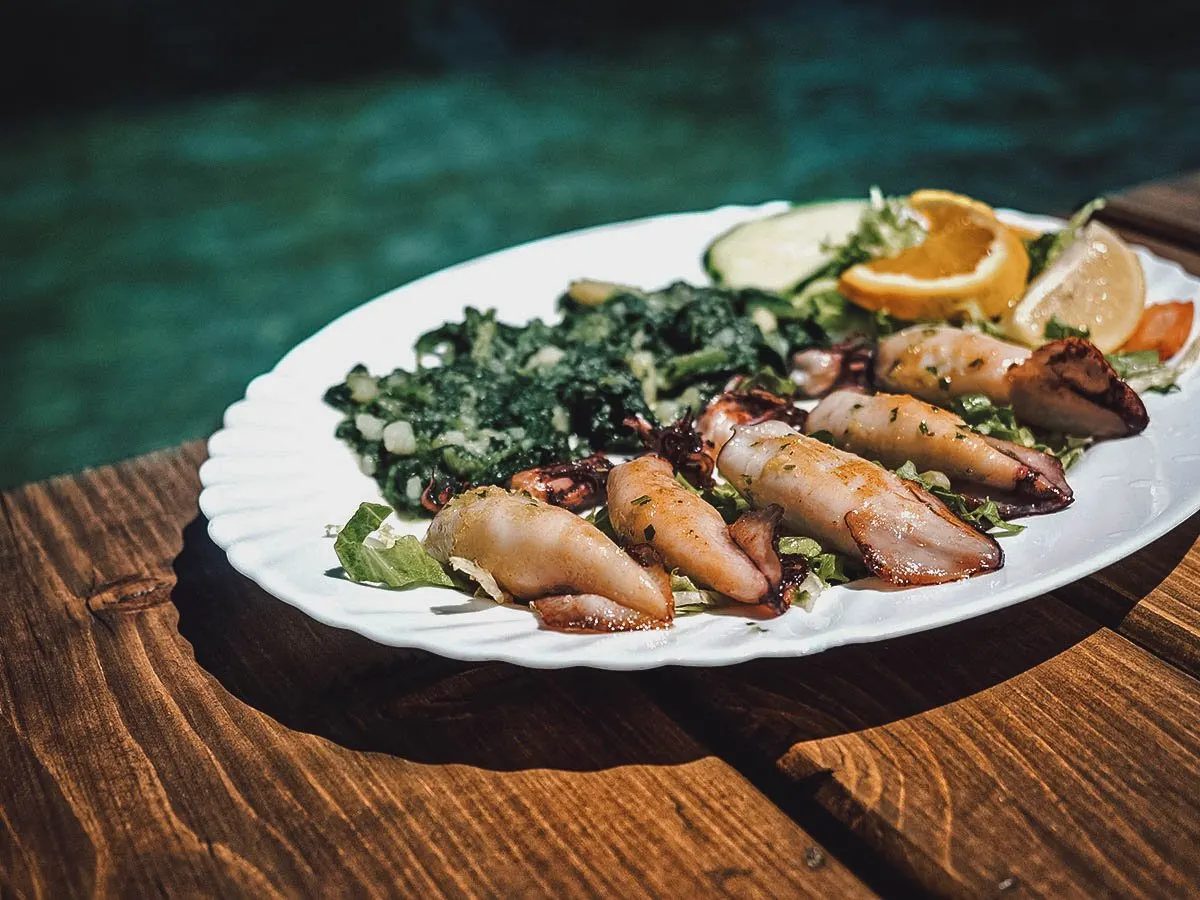
Photo by Artelier1986
31. Fiš Paprikaš
Popular in Croatia, Hungary, and Serbia, fiš paprikaš is a type of Croatian fish stew cooked in a cauldron over an open fire. It’s typically made with a variety of freshwater fish like catfish, carp, and pike flavored with copious amounts of the region’s staple spice – ground red paprika.
Fiš paprikaš is especially popular in the Croatian regions of Slavonia and Baranja where it’s often served with egg noodles.
DESSERTS / DRINKS
32. Čupavci
If you’re familiar with Australian food, then this next dish needs little introduction. Čupavci refers to the Croatian equivalent of lamingtons, the famous Australian sponge cake dipped in chocolate sauce and covered in desiccated coconut.
The lamington was believed to have been invented in the Governor of Queensland’s household (Lord Lamington) around the end of the 19th century. No one really knows how the cake made its way to the Balkans from Australia but it’s become a staple dessert in Croatian cuisine, so much so that Croatians are now believed to be the biggest makers and consumers of this classic dessert.
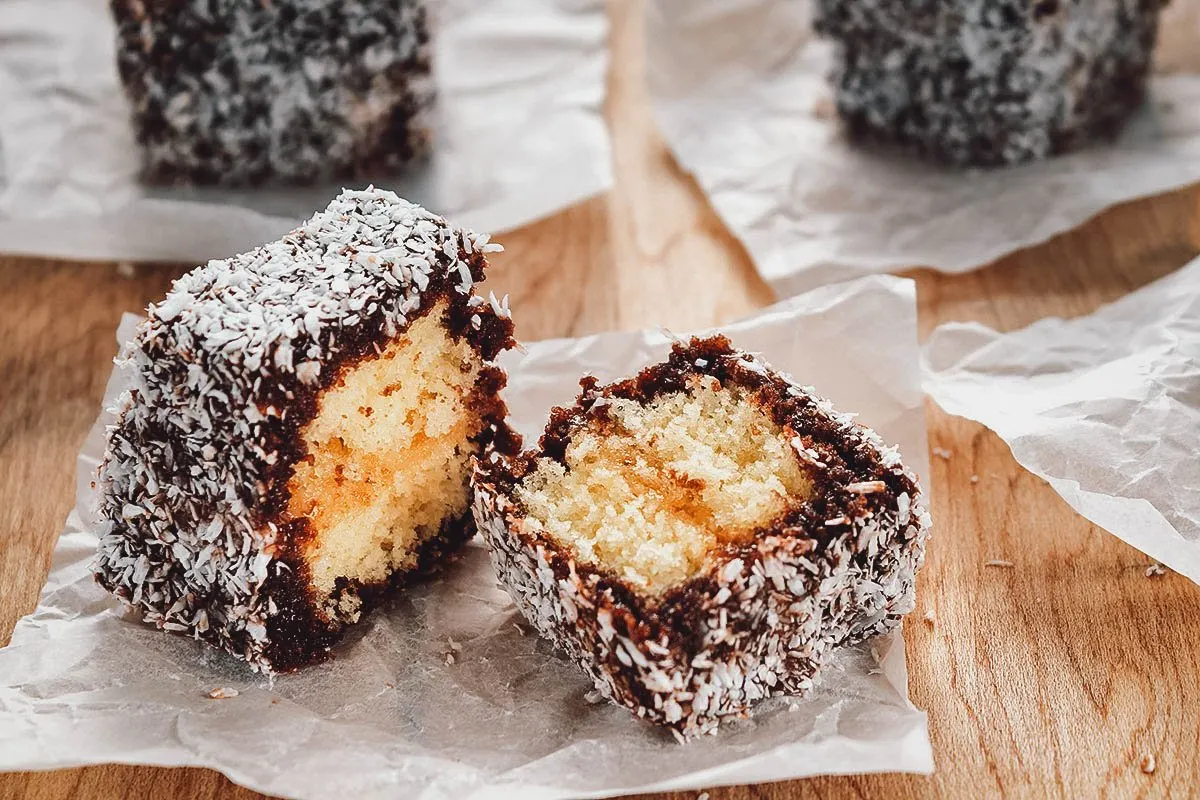
Photo by Dariozg
33. Makovnjača
Makovnjača is the Croatian equivalent to the poppy seed roll, a popular dessert in the cuisines of many countries throughout Central and Eastern Europe. It can be consumed at any time of the year though it’s typically associated with Easter and Christmas.
Recipes vary but makovnjača is typically made by rolling out the dough into a large sheet and spreading it over with a filling made from poppy seeds, hot milk, and sugar. The dough with filling is then rolled into a long cylinder or log before being brushed with melted butter and baked.
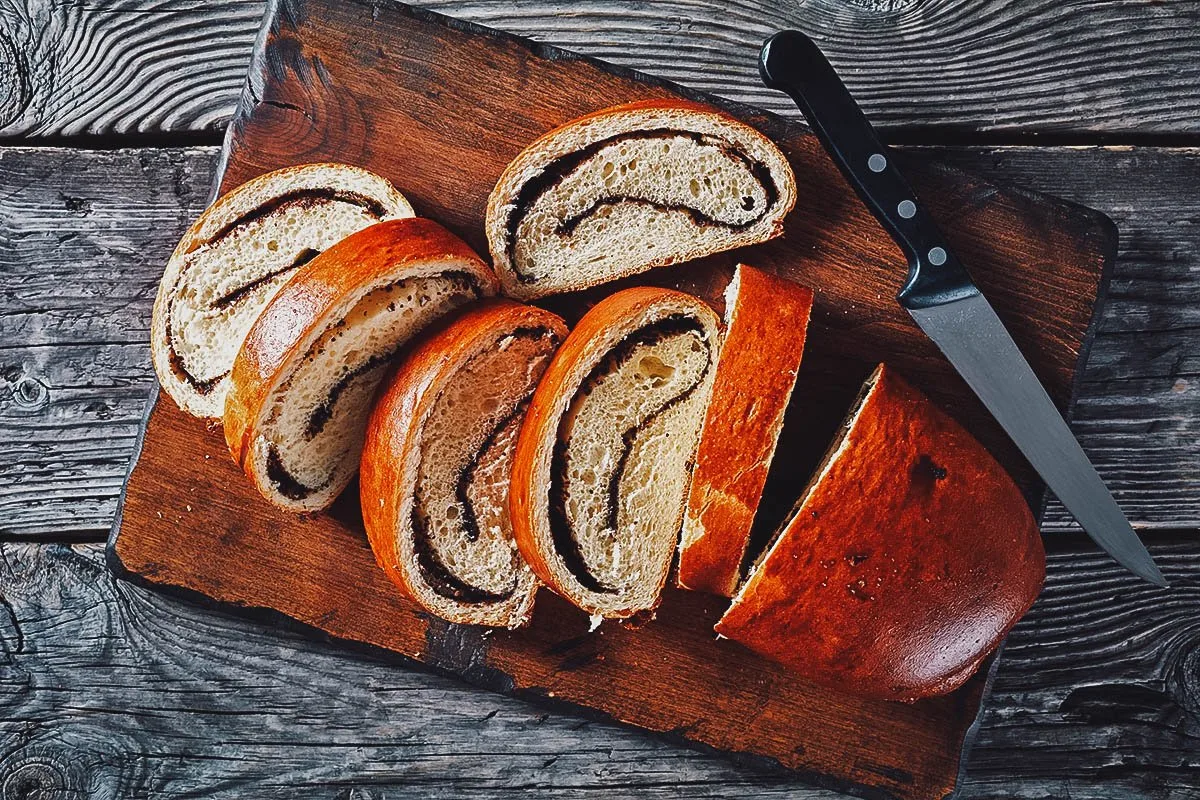
Photo by myviewpoint
If makovnjača looks appealing to you, then you may want to try orehnjača as well. It’s similar to makovnjača but instead of poppy seeds, it’s made with walnuts. A sweet yeast dough is rolled out thinly and spread over with a paste made from ground walnuts, honey, milk, butter, rum, lemon zest, and cinnamon. It’s rolled into a cylinder and brushed with an egg wash before baking.
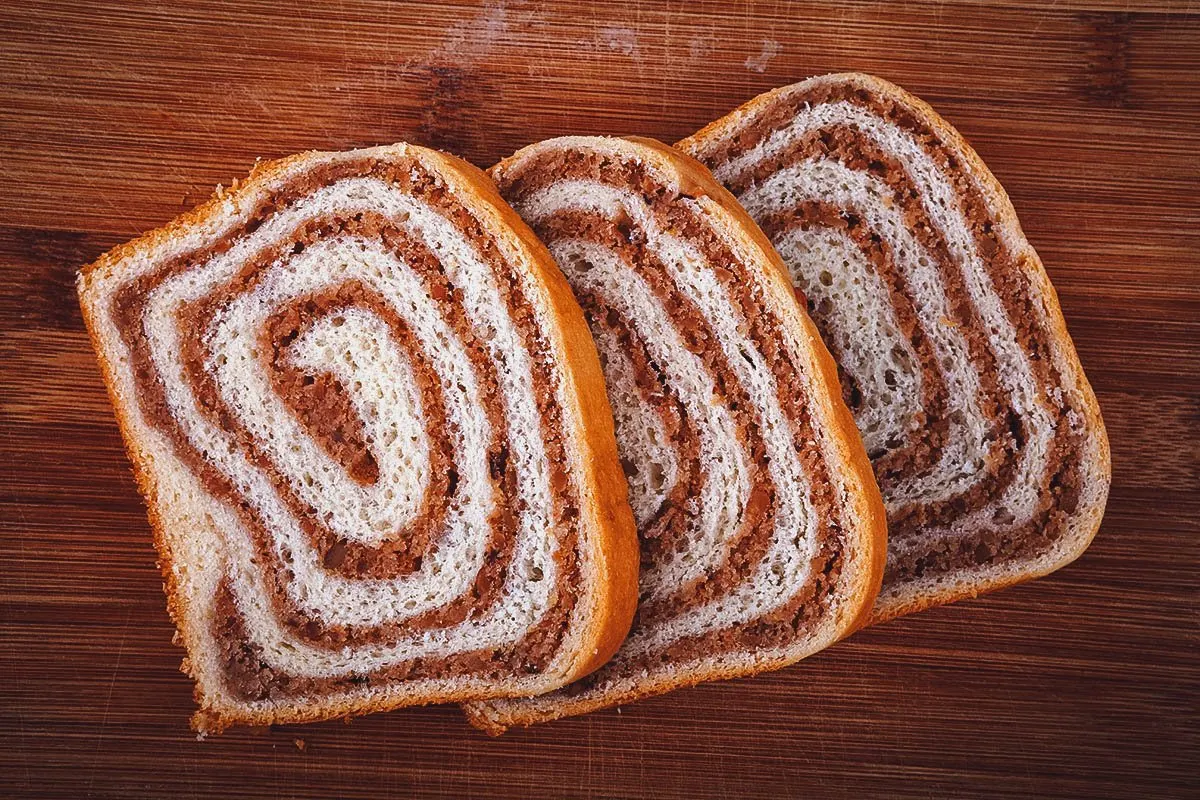
Photo by gsermek
34. Kremšnite
Kremšnite is the Croatian version of a custard and chantilly cream cake that’s popular in many countries throughout the Balkans and Central Europe like Hungary, Romania, Serbia, and Slovakia. Also known as vanilla or custard slice, it can be made in different ways depending on where it’s from but it always consists of custard cream and a puff pastry base.
In Croatia, two of the most popular versions are Samoborska kremšnita and Zagrebačka kremšnita. As their names suggest, the former is from the town of Samobor while the latter hails from Zagreb. Samoborska kremšnita is made with a puff pastry top and a predominantly custard cream filling (less whipped cream) while Zagrebačka kremšnita is topped with chocolate icing.
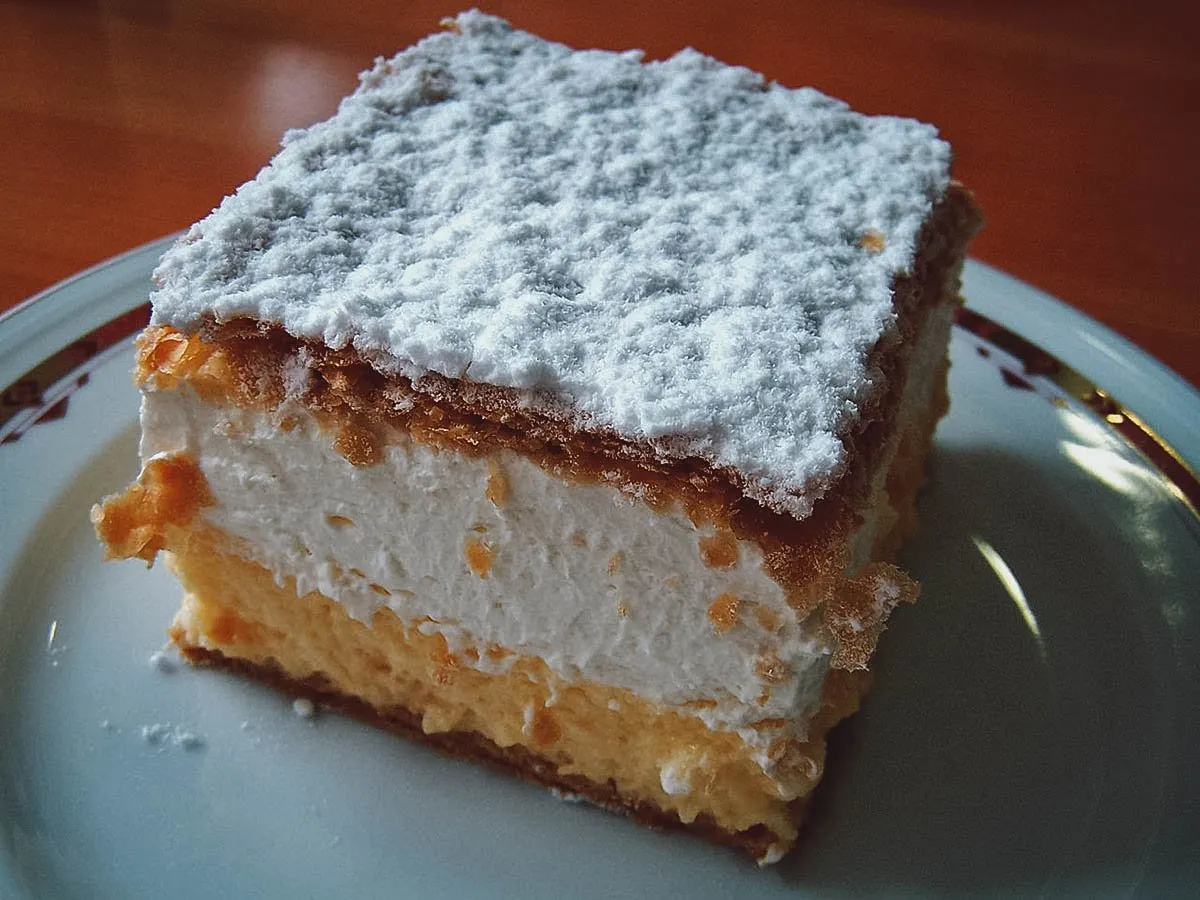
Photo by UkPaolo, CC BY-SA 3.0, via Wikimedia Commons / Processed in Photoshop and Lightroom
35. Fritule
Fritule are sweet round Croatian fritters. A traditional snack along the Dalmatian coast, they’re essentially a type of miniature doughnut made especially for Christmas.
Fritule can be made in a number of ways but they typically consist of a thick buttery base enriched with rum or brandy, vanilla, raisins, and citrus zest. The alcohol helps keep the fritters light and crispy by preventing the absorption of too much oil during the deep-frying process.
When ready, the fritters are traditionally dusted with powdered sugar but they can be coated with other toppings as well like melted chocolate, whipped cream, or caramel.
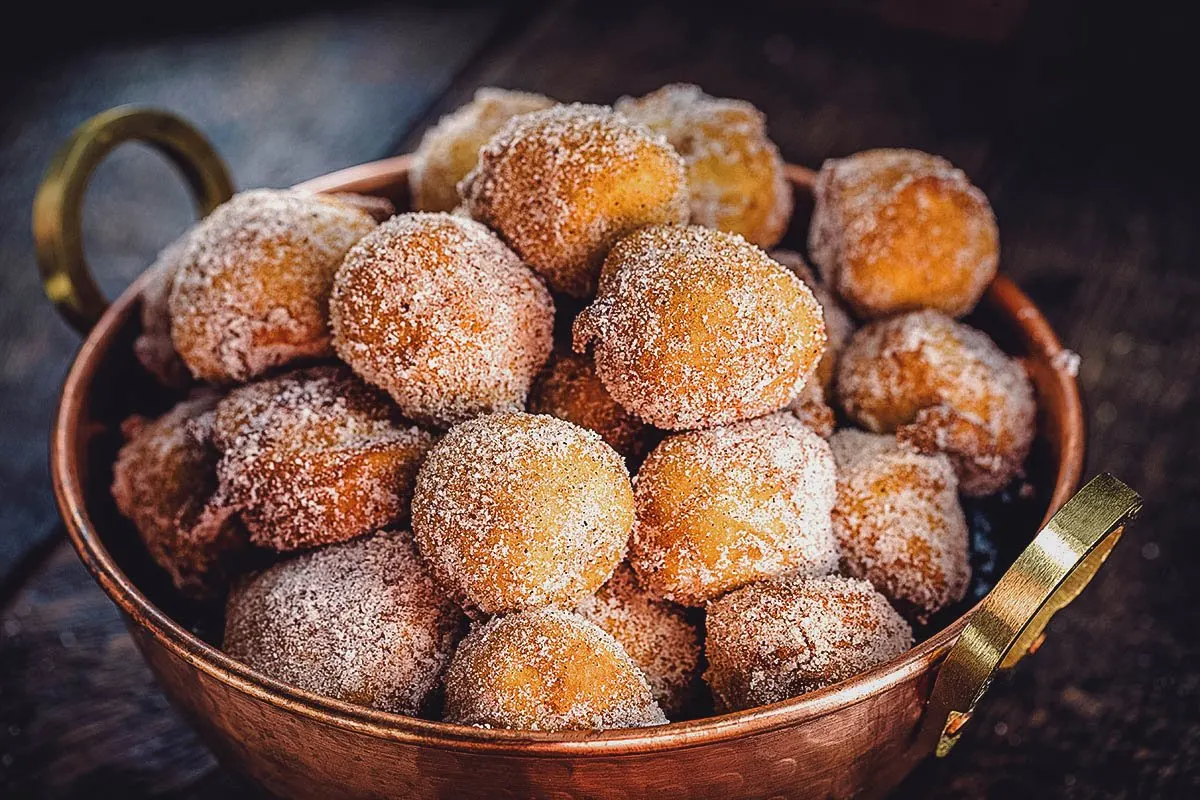
Photo by robertohunger
36. Krafne
If fritule sound appealing to you, then you’ll probably enjoy krafne, another type of doughnut that’s popular in many Balkan countries like Croatia, Bosnia and Herzegovina, Serbia, Slovenia, North Macedonia, and Albania. They’re similar to beignets or Berliners and can be filled with different ingredients like jam, marmalade, nutella, chocolate, custard pudding, and cinnamon.
In Croatia, krafne (or krofne, krofi) can be enjoyed year-round but they become especially popular during the winter festival of Carnival. Like fritule, they’re made with a dough enriched with vanilla, lemon zest, and rum or brandy to help keep the dough light and crispy.

Photo by chirapbogdan
37. Savijača
Savijača refers to a Croatian strudel, a type of layered pastry made with a sweet or savory filling. It’s originally an Austrian dish that’s become popular in the cuisines of many Central European countries like Croatia, Romania, Germany, Czechia, and Hungary.
Savijača can be filled with a variety of ingredients but the most common are apple and sour cherries. It can be consumed at any time of the year, but like many Croatian desserts, it becomes especially popular during the Christmas season.
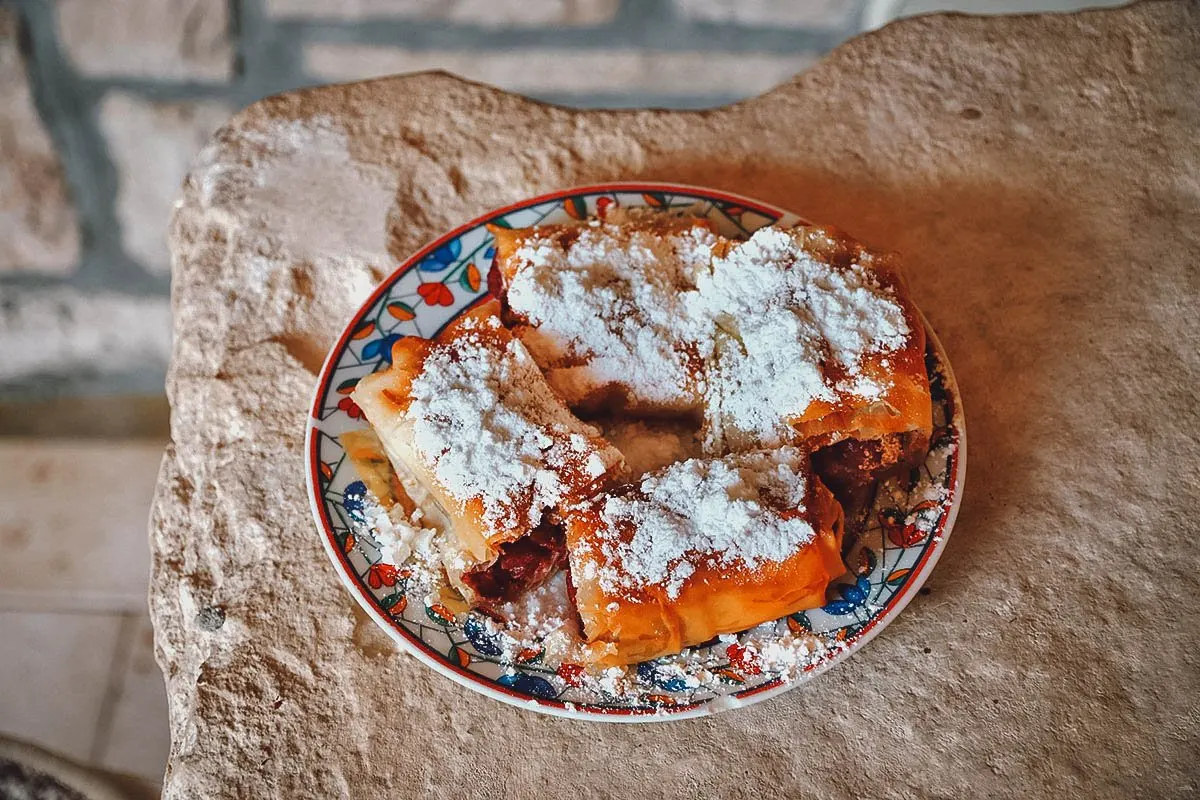
Photo by tupungato
38. Bajadera
Bajadera refers to a type of no-bake Croatian praline made with layers of ground almonds, hazelnuts, or walnuts mixed with chocolate, cookie biscuits, sugar syrup, and butter. It was invented and commercially produced by the Kraš confectionary company in Zagreb.
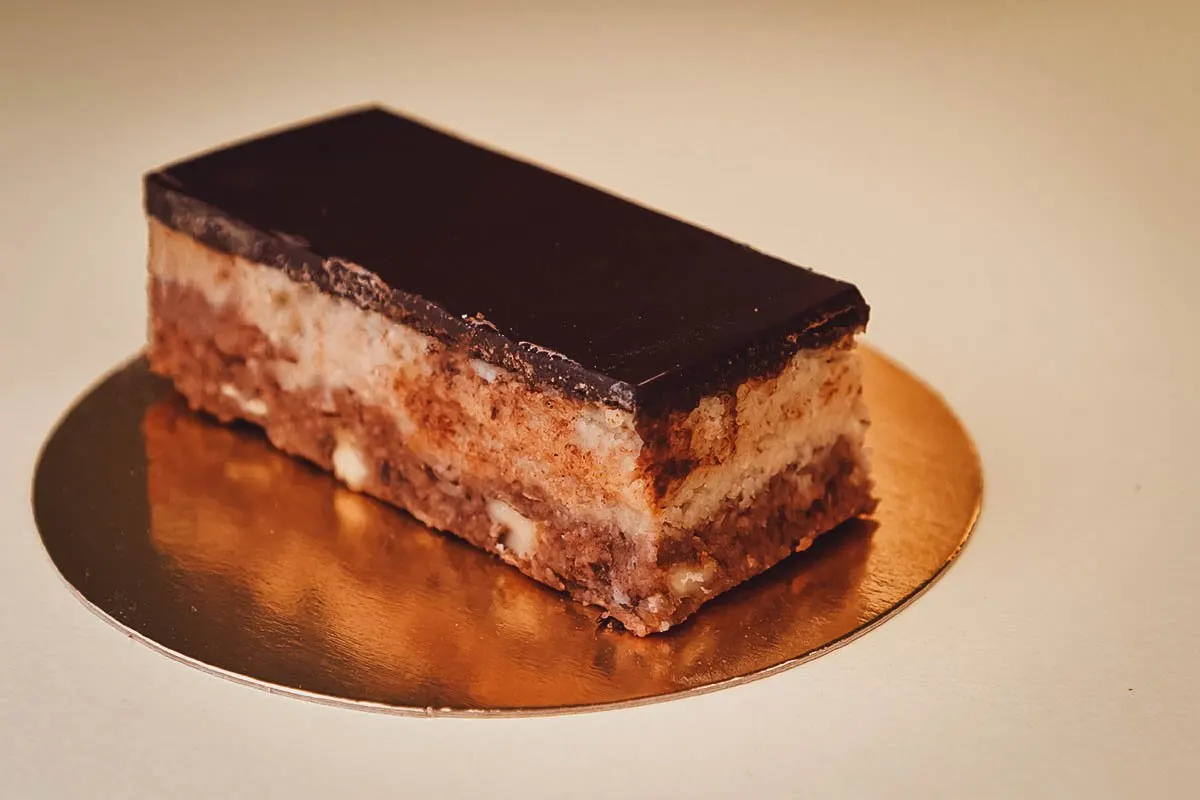
Photo by Kreminska
39. Cukarini
Cukarini are crispy and crumbly Croatian cookies made on the island of Korčula. They’re known for their subtle citrusy flavor and unusual shape which is said to resemble two serpents entangled in the shape of a heart. The cookie’s strange shape is said to stem from pagan times when serpents were used as a symbol of good fortune.
After baking, cukarini are dipped in a traditional rose liqueur and dusted with coarse or powdered sugar. They’re best enjoyed with a glass of prošek or sweet Croatian dessert wine.
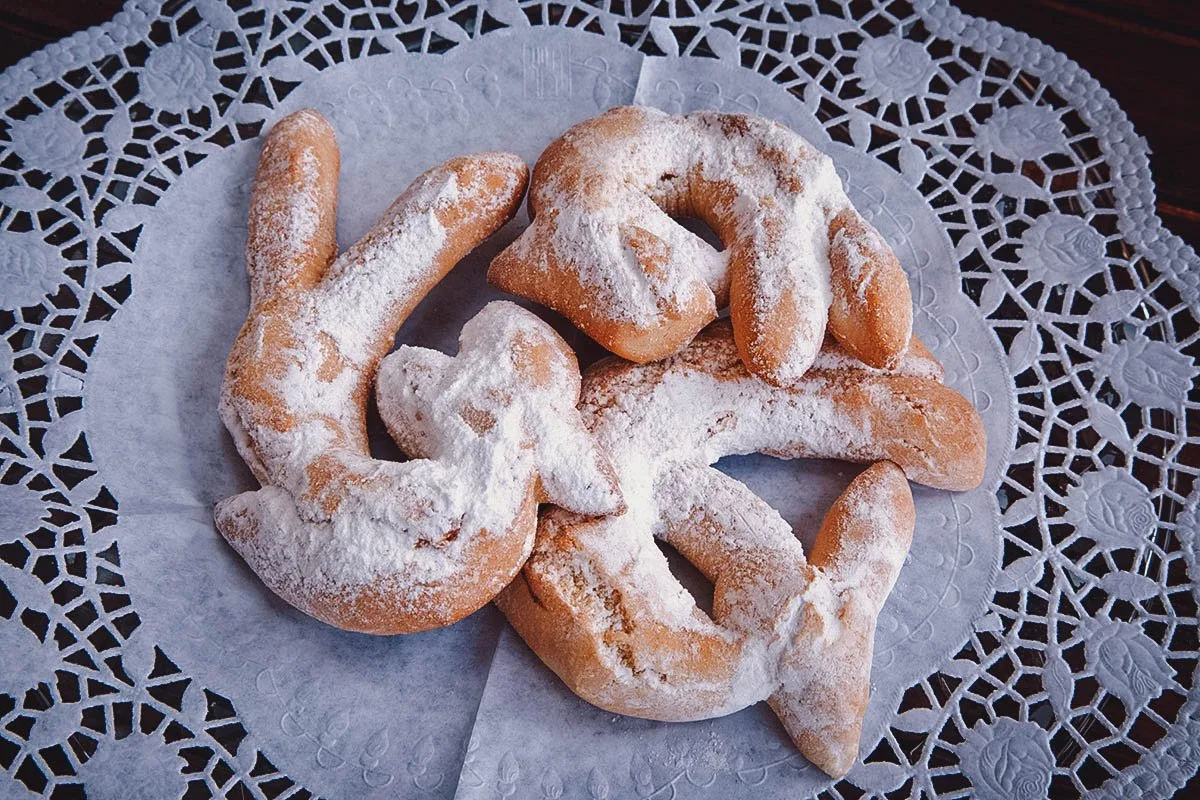
Photo by fineart
40. Istrian Malvazija
Vineyards abound from the Dalmatian Coast to Istria, and best known among Croatian wines may be Istria’s signature crisp white wine from the grape variety called Malvazija Istarska. It’s the perfect companion to seaside dining, from calamari and sardines to seafood pasta and snacks at sunset.
Istrian malvazija is fresh, light, and uncomplicated. Consequently, it’s praised and maligned in equal measure as a “breakfast wine.” But personally, I love unpretentious, drinkable white wine, especially when it’s so cheap! At the time, a bottle from the grocery store cost little more than 30-40 kuna (4-5 Euros), and one from one of the top vineyards such as Kozlovic Winery in Istria can be had for only 80 kunas (11 Euros).

Photo by rudakova
CROATIAN FOOD TOURS
Needless to say, no one knows traditional Croatian food better than a local, so what better way to experience the very best of Croatian food and drink than by going on a food tour? Not only will a knowledgeable guide take you to the city’s best markets and restaurants, but they’ll be able to explain all the dishes to you in more detail. Check out Get Your Guide for a list of Croatian food tours in Dubrovnik, Split, Zagreb, Zadar, Rovinj, Pula, and other destinations in Croatia.
CROATIAN COOKING CLASSES
Aside from going on a food tour, one of the best ways to learn about Croatian traditional food is to take a cooking class. Knowing what Croatian dishes to eat is one thing but learning how to actually make them is another. Taking a cooking class and working with the local ingredients provides a much more intimate look into the cuisine.
If you have a fondness for cooking and want to learn about authentic Croatian food recipes, then check out Cookly for a list of cooking classes in Croatia.
FINAL THOUGHTS ON TRADITIONAL CROATIAN FOODS
These foods represent but a small sliver of the culinary riches of this yet under-the-radar gem in the Adriatic. If I have whetted your appetite for a full-blown gastronomic tour of Croatia, do include a few days in Istria. After arriving in Zagreb, most travelers prioritize Split and Dubrovnik. But a stay in Istria is not to be missed, especially for lovers of food and drink.
I highly recommend staying in the town of Rovinj, where pretty, pastel-hued buildings seem to rise out of the sea…more on this in another article – “10 Days, 10 Reasons to Visit Croatia.”
And if you do visit Istria, a full-day food and wine tour with a local guide is the way to go, especially if your time in Istria is limited. We spent almost ten hours on a private tour with a local guide, a veritable sage on all things Istria. The best day of our 10-day jaunt, and worth every penny.
Disclosure
Some of the links in this article on Croatian food are affiliate links. If you make a booking, then we’ll earn a small commission at no additional cost to you. As always, we only recommend products and services that we use ourselves and firmly believe in. We really appreciate your support as it helps us make more of these free travel and food guides. Thank you!
Cover photo by Artelier1986. Stock images via Depositphotos.


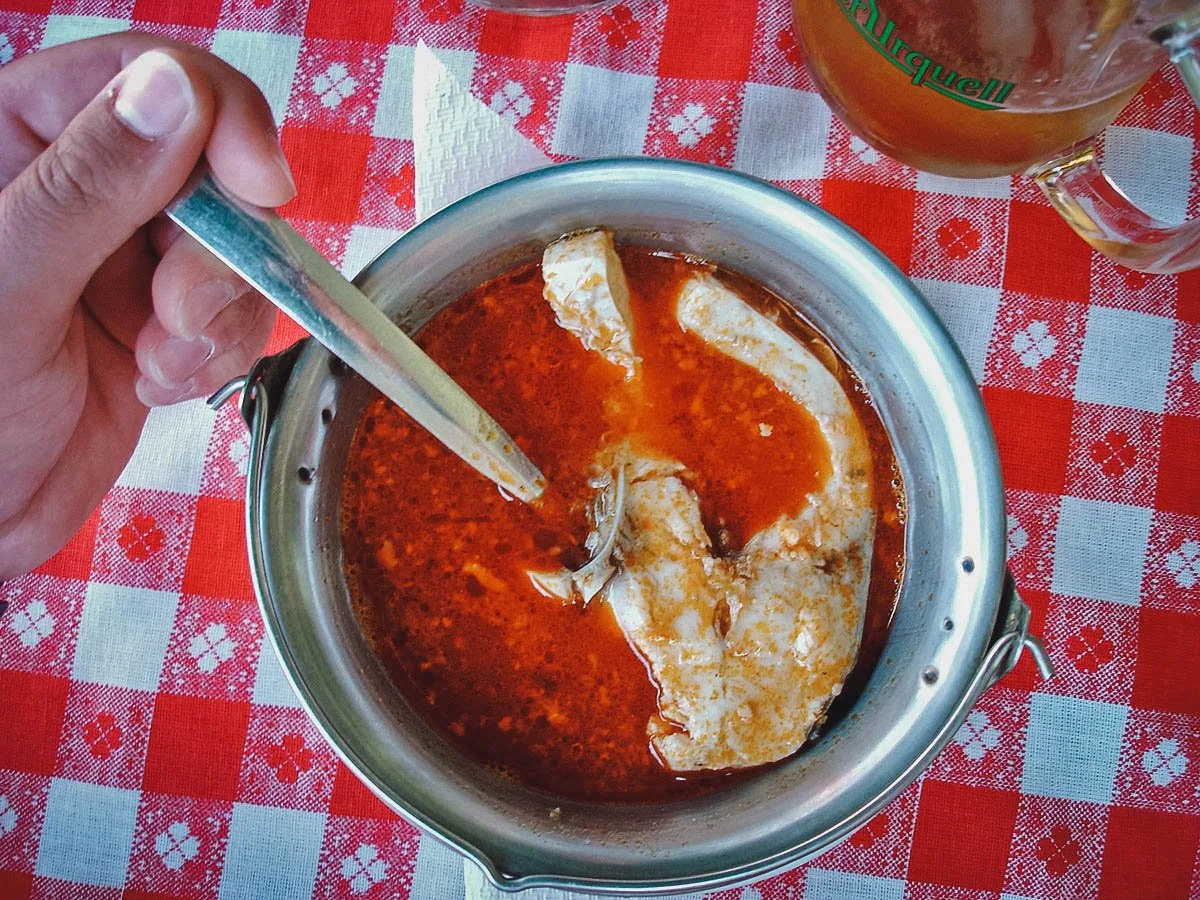
Lea
Tuesday 9th of August 2022
Thank you so much for making sure to add Istria to this list! We always get overlooked and it drives me nuts! Only one thing to add, if I may, is istarski pljukanci with šugo and TRUFFLES! Specifically served on top of a seared biftek in a truffle sauce with handmade pasta on the side (sometimes fuži). Loved this write up- thanks again!
JB & Renée
Tuesday 9th of August 2022
So happy you enjoyed the article Lea! Croatia is in our plans for 2023 so we'll definitely look for that dish! It sounds amazing.
Ivana
Wednesday 13th of July 2022
I'm Croatian, it's so funny how I recognise only half the dishes because I'm from coastal islands and not the mainland! This was nice.
JB & Renée
Friday 15th of July 2022
Happy to hear you appreciated it Ivana!
Pepe Samson
Tuesday 20th of October 2015
Wow, may contributors ka na! :)
No matter who wrote it, the articles here are always well-researched and well-written. With great pics of course. Love love love the new layout! Congrats!
JB & Renée
Tuesday 20th of October 2015
Thanks a lot Pepe! :)